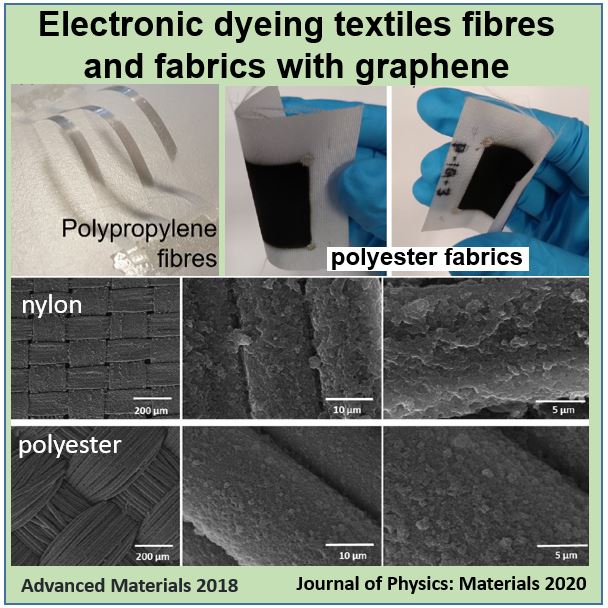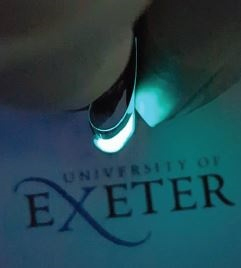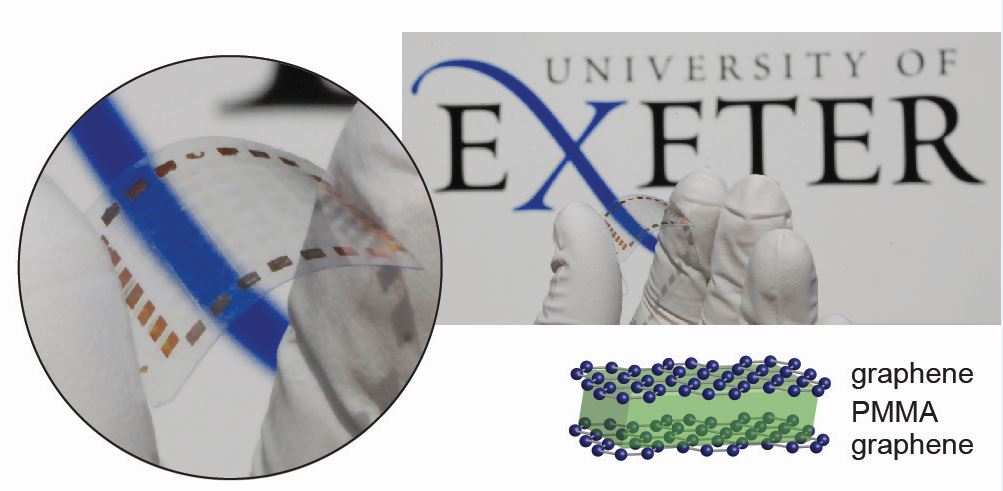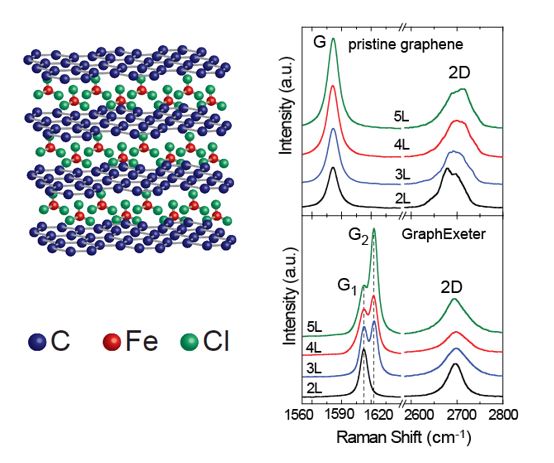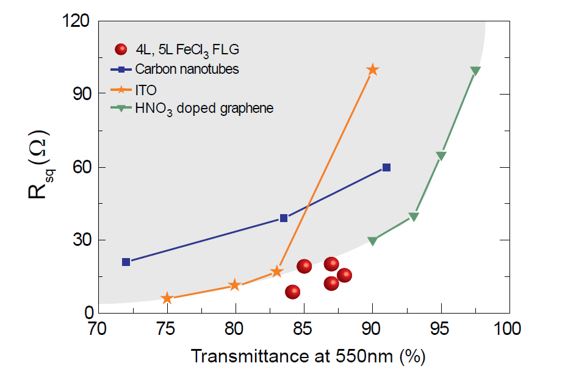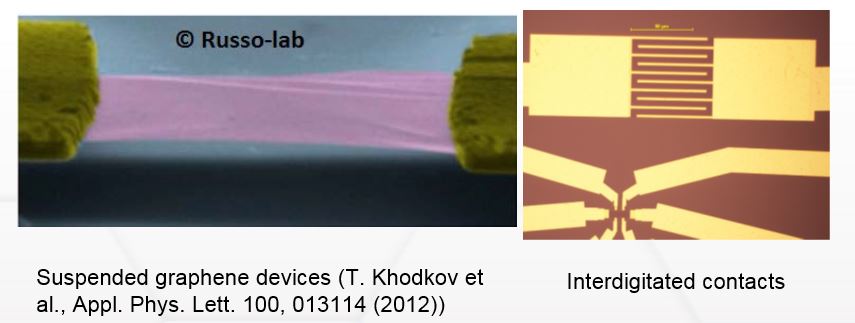Prof Monica Craciun
Professor in Nanoscience and Nanotechnology
(Streatham) 3656
01392 723656
Overview
Prof Monica Craciun is Professor in Nanoscience and Nanotechnology in the Engineering Department at the University of Exeter, UK. She is part of the Centre for Graphene Science, the Nano Engineering Science and Technology (NEST) Group and the Centre for Metamaterial Research and Innovation.
Prof Craciun has over 20 years of research expertise in the areas of Advanced Materials, Nanoscience and Nanotechnology. She held one of the 5-year EPSRC Engineering Fellowships for Growth awarded to only 8 UK leading academics for maintaining UK’s research leadership the area of Advanced Materials (identified as one of the Great British Technologies). Prof Craciun is/was investigator on more than 30 EPSRC, Royal Society, Innovate UK, EU and industrial research grants with a total funding of over £10 million.
The academic work of Prof Craciun spans from engineering research in nanotechnology, electronic and optoelectronic devices to fundamental science research in nanoscience (quantum phenomena, molecular electronics, nano electronics, spintronics) and materials science (discovery of new materials and manufacturing methods, understanding the properties-performance relationship). She has over 160 publications in leading international journals (e.g. Nature & Science family journals, Advanced Materials, Nano Letters), with many papers ranked in the top 1% in Materials Science, Engineering and Physics, which have attracted an h-index of 45, an i10-index of 85 and more than 6700 citations. Prof Craciun leads a research group working on two-dimensional materials with the aim of harnessing their novel properties for electronics, photonics, energy, sensing and healthcare.
Prof Craciun gained a PhD in Applied Physics from Delft University of Technology (The Netherlands), an MSc in Materials Physics (Joseph Fourier University, Grenobe, France), an MSc in Applied Physics (University of Bucharest, Romania) and an MSc in Materials Engineering (Catholic University Leuven, Belgium). Before joining Exeter she was postdoctoral researcher at the University of Twente (The Netherlands) and at the University of Tokyo were she was awarded a prestigious fellowship of the Japanese Society for the Promotion of Science. Prof Craciun joined the University of Exeter in January 2010 as research fellow and took up her current position in April 2017.
Several research fellows such as Marie Curie and Royal Academy of Engineering were hosted and mentored by Prof Craciun. She also mentored 13 postdoctoral researchers and is/was supervisor of more than 30 PhD students (17 to completion), as well as more than 60 Msc, MEng, BEng and MPhys dissertation students. Several of the researchers supervised by Prof Craciun have progressed to academic positions or are in leadership positions in industry, as detailed on the former group members page.
Research interests
The research of Prof Craciun is at the forefront of nanoscale Engineering and Materials Science, spanning from nanoscience & nanotechnology to electronic & optoelectronic technologies, with a highly interdisciplinary activity reaching out Condensed Matter Physics, Chemistry and Bioscience.
-
Electronic and optoelectronic materials and devices.
The aim of this area is the exploitation of 2D materials with extraordinary performances in electronic and optoelectronic devices and their drive towards the next-generation technology. Contributions to this area include novel techniques to pattern electrical circuits in Fluorine- functionalised graphene, of use for whole-graphene electronics [Nano Lett. 11, 3912 (2011)], a method to tailor the band gap of fluorinated graphene by tuning the Fluorine coverage [Nanoscale Res. Lett. 6, 526, (2011) & New J. Phys. 15, 033024 (2013)]. In terms of materials advances, our team developed a new growth method for graphene which is 100 times faster and 99% lower cost than standard Chemical Vapor Deposition [Adv. Mater. 27, 4200 (2015)], allowing semiconductor industry a way to mass produce graphene with present facilities rather than requiring them to build new manufacturing plants. We also developed the GraphExeter material (i.e. few-layer graphene intercalated with FeCl3), the best carbon-based transparent conductor [Adv. Mater. 24, 2844 (2012)], with resilience to extreme conditions [Nature Sci. Rep. 5, 7609 (2015)], extensively reported by media such as BBC, Forbes and Reuters. We demonstrated the potential of GraphExeter for flexible electronics [Nature Sci. Rep. 5, 16464 (2015)], transparent photo-detectors [ACS Nano 7, 5052 (2013)], foldable light emitting devices [ACS Appl. Mater. Int. 8, 16541 (2016)], used GraphExeter to provide the first evidence for magnetic ordering in the extreme limit of 2D systems [Nano Lett 14, 1755 (2014)] and demonstrated GraphExeter as a plasmonic material with unprecedented capabilities in infrared [Nano Lett. 17, 5908 (2017)]. Our group also contributed to the development of a method to accurately produce MoTe2 layers and control their thickness for electronics and optoelectronics [Adv. Funct. Mater. 28 1804434 (2018)]. The most recent innovation is the development of laser-writable high-k dielectric for 2D nanoelectronics [Science Advances 5, eaau0906 (2019)]. Our advances in optoelectronics include the intelligent design of fast and highly efficient atomically thin optoelectronic devices [Adv. Mater. (2017)], a novel method to engineer photodetectors in GraphExeter for ultrathin, high-definition sensing and video imaging technologies [Science Advances (2017)], 2D heterostructures for video-frame-rate imaging [Adv. Mat. 2017]. Recently we presented the first experimental evidence of an electron funnel on a chip [Nature Communications 9, 1652 (2018)], a technology that could unlock new ways of ‘funnelling’ the sun’s energy more efficiently directly into solar panels or batteries.
-
Wearable/flexible electronics and optoelectronics.
Our research has greatly contributed to the state-of-the-art in this field, as our group was among the first to report 2D materials based technologies for textile electronics [Nature Sci. Rep. 5, 9866 (2015) & Nature Sci. Rep.7, 4250 (2017)] and artificial skin [Adv. Mater. 27, 4200 (2015)]. These contributions effectively opened up the emerging field of electronic textiles to the thinnest materials ever conceived: atomically thin materials. In this area, our group also contributed to the demonstration of ultra-small, ultra-fast and flexible non-volatile graphene memories [ACS Nano 11, 3010 (2017)]. We also pioneered a new technique to create graphene electronic textile fibres that can function as touch-sensors and light-emitting devices [npj Flexible Electronics 2, 25 (2018)] and demonstrated fabric-enabled pixels for displays and position sensitive functions, constituting a gateway for novel electronic skin, wearable electronic and smart textile applications. Recent advances are on the integration of high‐quality graphene films obtained from scalable water processing approaches in emerging energy harvesting devices [Adv. Mater. 30, 1802953 (2018)], opening new possibilities for self-powered electronic skin, flexible and wearable electronics. Based on this technology we developed a method for the fabrication of micrometer-sized well-defined patterns in water-based 2D materials [Adv. Sci. 6, 1802318 (2019)]. This method was used to create humidity sensors with performance comparable to that of commercial ones. These sensor devices are fabricated onto a 4 inch polyethylene terephthalate (PET) wafers to create all-graphene humidity sensors that are flexible, transparent, and compatible with current roll-to-roll workflow.
-
Quantum Engineering & Nano Electronics.
We use nano-electronic devices to investigate the electronic properties of graphene, functionalized graphene and of other 2D materials. This encompasses quantum phenomena studies as well as application of these materials in photodetectors, p-n diodes, transistors and memories. Main contributions from our group include the first experimental demonstration of charge carriers propagation in monolayer graphene via evanescent waves [Phys. Rev. Lett. 100, 196802 (2008)] and the discovery that ABA-stacked trilayer graphene is the only gate-tuneable semimetal [Nature Nanotech. 4, 383 (2009)], opening the research area of few-layer graphene (FLG). We also published the first experimental evidence that trilayer graphene has a unique stacking-dependent quantum Hall effect [Phys. Rev. B(R) 84, 161408 (2011)], the first studies of electrical transport in FLG with record high charge densities controlled by liquid ionic gating [PNAS 108, 13002 (2011)], and the first direct observation of the electric field tuneable energy gap in ABC-stacked trilayer graphene [Nano Lett. 15, 4429 (2015)]. Other advances are the realisation of a highly efficient graphene Cooper pair splitter device for quantum information processing [Nature Sci. Rep. 6, 23051 2016], and revealing the mechanism of large distance supercurrent propagation through graphene-superconductor junctions [Nano Lett. 16, 4788 (2016)]. We also developed novel ways to strain graphene [Nano Lett. 14, 1158 (2014)] which were used to experimentally study electron states in uniaxially strained graphene [Nano Lett. 15, 7943 (2015)], of interest for straintronics applications. We also probed different strain configuration in 2D superlattices and provided a new mechanism to induce complex strain patterns in 2D materials [Nano Lett. 18, 7919 (2018)], with profound implications in the development of future electronic devices based on heterostructures. Our latest contribution in this area is the demonstration of electrical tuning up to room temperature of optically active interlayer excitons in bilayer MoS2 [Nature Nanotechnology, (2021)].
-
Molecular and Organic Electronics.
This was was the focus area of my PhD. Highlights include the discovery of a correlation between the electrical conduction of metal-phthalocyanine (MPc) materials and the molecular structure of their constituent molecules [J. Am. Chem. Soc. 127, 12210 (2005)] and the realisation of the first MPc ambipolar transistor [Appl. Phys. Lett. 86, 262109 (2005)]. This was followed by the first demonstration of high electrical conductivity in alkali-doped MPc [Adv. Mater. 18, 320 (2006)], which opened up the field of metallic MPc. I also published the first experimental observation of an insulating state in pentacene induced by strong interactions between the conduction electrons [Phys. Rev. B 79, 125116 (2009)]. This is still an active field in my group, but with a focus on hybrid 2D-organic materials systems and device engineering. Our latest advance is the demonstration of novel devices for imaging at ultralow light levels based on organic semiconductors and graphene interfaces [Adv, Mater. 29, 1702993 (2017)]. Such devices pave the way for the implementation of low-cost, flexible imaging technologies at ultralow light levels.
-
2D materials for civil engineering
The aim of this area is harnessing the novel properties of graphene and related materials in order to drive them towards applications in civil engineering. In this area our group has demonstrated ultrahigh performance nanoengineered Graphene–Concrete composites with an unprecedented range of enhanced and multifunctional properties compared to standard concrete [Adv. Func. Mater. 2018]. These include an increase of up to 146% in the compressive strength, up to 79.5% in the flexural strength, and a decrease in the maximum displacement due to compressive loading by 78%. We have also contributed to the demonstration of Graphene–Rubber layered functional composites for seismic isolation of structures [Adv. Eng. Mater. 2020]). In this work, novel graphene-reinforced elastomeric isolators (GREI) are proposed. Elastomeric isolators (EIs) are devices used for seismic isolation of structures, made of alternate layers of steel and rubber, and positioned between the structure and its foundations to decouple them. The heavy weight and complex manufacturing process of steel based EIs drives costs up, restricting their use to strategic buildings such as hospitals and civic centers. As a promising alternative, GREI is proposed here to overcome the heavy weight and long manufacturing process of steel based devices and the mechanical limitation to seismic excitations of alternative technologies such as glass or carbon fiber-reinforced EIs.
Selected publications
- Namphung Peimyoo, Thorsten Deilmann, Freddie Withers, Janire Escolar, Darren Nutting, Takashi Taniguchi, Kenji Watanabe, Alireza Taghizadeh, Monica Felicia Craciun, Kristian Sommer Thygesen, Saverio Russo.Electrical tuning of optically active interlayer excitons in bilayer MoS2. Nature Nanotechnology, (2021) https://doi.org/10.1038/s41565-021-00916-1.
- Darren Nutting, Jorlandio F Felix, Evan Tillotson, Dong-Wook Shin, Adolfo De Sanctis, Hong Chang, Nick Cole, Saverio Russo, Adam Woodgate, Ioannis Leontis, Henry A Fernández, Monica F Craciun, Sarah J Haigh, Freddie Withers. Heterostructures formed through abraded van der Waals materials. Nature Communications volume 11, Article number: 3047 (2020)
- Namphung Peimyoo, Hsin-Yu Wu, Janire Escolar, Adolfo De Sanctis, Gabi Prando, Frank Vollmer, Freddie Withers, Anders Christian Riis-Jensen, Monica Felicia Craciun, Kristian Sommer Thygesen, Saverio Russo.ACS Applied Materials and Interfaces. 12, 49, 55134–55140 (2020)
- Gopika Rajan, Joseph J Morgan, Conor Murphy, Elias Torres Alonso, Jessica Wade, Anna K Ott, Saverio Russo, Helena Alves, Monica F Craciun, Ana IS Neves. Low Operating Voltage Carbon–Graphene Hybrid E-textile for Temperature Sensing. ACS Applied Materials and Interfaces. 12, 26, 29861-29867 (2020).
- Torres Alonso E, Shin DW, Rajan G, Neves AIS, Russo S, Craciun MF. Water-Based Solution Processing and Wafer-Scale Integration of All-Graphene Humidity Sensors, Advanced Science, volume 6, no. 15 (2019).
- Peimyoo N, Barnes MD, Mehew JD, De Sanctis A, Amit I, Escolar Ulibarri J, Anastasiou K, Rooney AP, Haigh SJ, Russo S. Laser writable high-K dielectric for van der Waals nanoelectronics, Science Advances, volume 5, article no. eaau0906 (2019).
- Nagareddy VK, Octon TJ, Townsend NJ, Russo S, Craciun MF, Wright CD. (2018) Humidity-Controlled Ultralow Power Layer-by-Layer Thinning, Nanopatterning and Bandgap Engineering of MoTe2, Advanced Functional Materials, volume 28, no. 52
- Shin D-W, Barnes MD, Walsh K, Dimov D, Tian P, Neves AIS, Wright CD, Yu SM, Yoo J-B, Russo S. A New Facile Route to Flexible and Semi-Transparent Electrodes Based on Water Exfoliated Graphene and their Single-Electrode Triboelectric Nanogenerator, Advanced Materials, volume 30, no. 39 (2018)
- Torres Alonso E, Rodrigues D, Khetani M, Dong-Wook S, De Sanctis A, Joulie H, de Schrijver I, Baldycheva A, Alves H, Neves AIS. Graphene electronic fibres with touch-sensing and light-emitting functionalities for smart textiles, npj Flexible Electronics, volume 2, pages 25-25, article no. 25 (2018)
- Dimov D, Amit I, Gorrie O, Barnes M, Townsend N, Neves AIS, Withers F, Russo S, Craciun M. Ultrahigh Performance Nanoengineered Graphene–Concrete Composites for Multifunctional Applications, Advanced Functional Materials, pages 1705183-1705183, article no. 1705183 (2018)
- De Sanctis A, Amit I, Hepplestone S, Craciun M, Russo S. Strain-engineered inverse charge-funnelling in layered semiconductors, Nature Communications, volume 9, article no. 1652 (2018)
- Jones GF, Pinto RM, De Sanctis A, Nagareddy KV, Wright DC, Alves H, Craciun MF, Russo S. Highly Efficient Rubrene–Graphene Charge-Transfer Interfaces as Phototransistors in the Visible Regime, Advanced Materials, article no. 1702993 (2017)
- De Sanctis A, Jones GF, Wehenkel D, Bezares F, Koppens FHL, Craciun, Russo. Extraordinary linear dynamic range in laser-defined functionalized graphene photodetectors, Science Advances, volume 3, no. 5, article no. e1602617 (2017)
- Mehew JD, Unal S, Torres Alonso E, Jones GF, Fadhil Ramadhan S, Craciun MF, Russo S. Fast and Highly Sensitive Ionic Polymer Gated WS2-Graphene Photodetectors, Advanced Materials, (2017)
- Bezares FJ, Sanctis AD, Saavedra JRM, Woessner A, Alonso-González P, Amenabar I, Chen J, Bointon TH, Dai S, Fogler MM. Intrinsic Plasmon-Phonon Interactions in Highly Doped Graphene: A Near-Field Imaging Study, Nano Letters, DOI:10.1021/acs.nanolett.7b01603 (2017)
- Nagareddy KV, Barnes MD, Zipoli F, Lai KT, Alexeev AM, Craciun MF, Wright CD. Multilevel Ultra-Fast Flexible Nanoscale Non-Volatile Hybrid Graphene Oxide - Titanium Oxide Memories, ACS Nano (2017).
- Amit I, Octon TJ, Townsend NJ, Reale F, Wright CD, Mattevi C, Craciun MF, Russo S. Role of Charge Traps in the Performance of Atomically Thin Transistors, Advanced Materials, pages 1605598-1605598 (2017)
- Ke, Chung-Ting; Borzenets, Ivan; Draelos, Anne; Amet, Francois ; Bomze, Yuriy; Jones, Gareth; Craciun, Monica; Russo, Saverio; Yamamoto, Michihisa ; Tarucha, Seigo; Finkelstein, Gleb. Critical Current Scaling in Long Diffusive Graphene-Based Josephson Junctions. Nano Letters, volume 16 (8), pp 4788–4791 (2016)
- Alexeev A, Barnes MD, Nagareddy VK, Craciun MF, Wright CD. A simple process for the fabrication of large-area CVD graphene based devices via selective in situ functionalization and patterning, 2D Materials, volume 4, pages 011010-011010 (2016).
- Torres Alonso E, Karkera G, Jones GF, Craciun MF, Russo S. (2016) Homogeneously Bright, Flexible, and Foldable Lighting Devices with Functionalized Graphene Electrodes, ACS Appl Mater Interfaces, volume 8, no. 26, pages 16541-16545, DOI:10.1021/acsami.6b04042
- Bointon TH, Barnes MD, Russo S, Craciun MF. (2015) High Quality Monolayer Graphene Synthesized by Resistive Heating Cold Wall Chemical Vapor Deposition, Advanced Materials, DOI:10.1002/adma.201501600
- Khodkov T, Khrapach I, Craciun MF, Russo S. (2015) Direct observation of a gate tunable band-gap in electrical transport in ABC-trilayer graphene, Nano Letters, DOI:10.1021/acs.nanolett.5b00772
- Hartley AM, Zaki AJ, McGarrity AR, Robert-Ansart C, Moskalenko AV, Jones GF, Craciun MF, Russo S, Elliott M, Macdonald JE. (2015) Functional modulation and directed assembly of an enzyme through designed non-natural post-translation modification, Chemical Science, DOI:10.1039/C4SC03900A.
- Shioya H, Russo S, Yamamoto M, Craciun MF, Tarucha S. (2015) Electron States of Uniaxially Strained Graphene, Nano Letters, DOI:10.1021/acs.nanolett.5b03027
- Approaching magnetic ordering in graphene materials by FeCl3 intercalation, T H Bointon, I Khrapach, R Yakimova, A V Shytov, M F Craciun, and S Russo, Nano Letters, 14 (4), pp 1751–1755 (2014)
- Straining graphene using thin film shrinkage methods, H. Shioya, M.F. Craciun, S. Russo, M. Yamamoto, S. Tarucha ,Nano Letters, 14 (3), 1158–1163, (2014).
- All-Graphene Photodetectors, F. Withers, T. H. Bointon, M. F. Craciun, S. Russo, ACS Nano 7, 5052 (2013).
- Novel highly conductive and transparent graphene based conductors, I. Khrapach, F. Withers, T. H. Bointon, D. K. Pplyushkin, W. L. Barnes, S. Russo, M. F. Craciun, Adv. Mater. 24, 2844 (2012).
- Tuneable elctronic properties in graphene, M. F. Craciun, S. Russo, M. Yamamoto, S. Tarucha, Nano Today. 6, 42 (2011).
- Accessing the transport properties of graphene and its multilayers at high carrier density, J. Ye, M. F. Craciun, M. Koshino, S. Russo, S. Inoue, H. Yuan, H. Shimotani, A. F. Morpurgo, Y. Iwasa, PNAS 108, 13002 (2011).
- Nanopatterning of fluorinated graphene by electron beam irradiation, F. Withers, T. H. Bointon, M. Dubois, S. Russo, M. F. Craciun, Nano Lett. 11, 3912 (2011).
- Trilayer graphene is a semimetal with a gate-tunable band overlap, M. F. Craciun, S. Russo, M. Yamamoto, J. B. Oostinga, A. F. Morpurgo, S. Tarucha, Nature Nanotech. 4, 383 (2009).
- Shot noise in ballistic graphene, Daneau R, Wu F, Craciun MF, Russo S, Tomi MY, Salmilehto J, Morpurgo AF, Hakonen PJ. , Phys Rev Lett, 100, 196802 (2008).
- Electronic transport through electron-doped metal phthalocyanine materials, M. F. Craciun, S. Rogge, M. J. L. Den Boer, S. Margadonna, K. Prassides, Y. Iwasa, A. F. Morpurgo, Adv. Mater. 18, 320 (2006).
- Correlation between molecular orbitals and doping dependence of the electrical conductivity in electron-doped metal-phthalocyanine compounds, M. F. Craciun, S. Rogge, A. F. Morpurgo, J. Am. Chem. Soc. 127, 12210 (2005).
Teaching activities
- Fundamentals of Mechanics, Materials and Electronics, 1st year all Engineering (2020-2022)
- Analogue and Digital Electronics Design, 2nd year Electronic Engineering (2011 – 2014, 2019 – 2020)
- Individual project coordinator, 3rd year all Engineering (2013 – 2014, 2019 – 2022)
- Group project coordinator, 4th year all Engineering (2013 – 2014)
- Commercial and Industrial Experience coordinator, 3rd year all Engineering (2013 – 2014)
- Contemporary Advanced Materials Research, Msc Materials Engineering (2011 – 2014)
Publications
Copyright Notice: Any articles made available for download are for personal use only. Any other use requires prior permission of the author and the copyright holder.
| 2024 | 2023 | 2022 | 2021 | 2020 | 2019 | 2018 | 2017 | 2016 | 2015 | 2014 | 2013 | 2012 | 2011 | 2010 | 2009 | 2008 | 2007 | 2006 | 2005 | 2004 | 2003 | 2002 | 2000 | Patents |
2024
- Kovalska E, Lam HT, Saadi Z, Mastria R, Neves AIS, Russo S, Craciun MF. (2024) Textile beeswax triboelectric nanogenerator as self-powered sound detectors and mechano-acoustic energy harvesters, Nano Energy, volume 120, pages 109109-109109, article no. 109109, DOI:10.1016/j.nanoen.2023.109109. [PDF]
2023
- Russo S, Craciun MF. (2023) Tuneable excitons in emerging 2D materials, 2023 IEEE Nanotechnology Materials and Devices Conference, NMDC 2023, DOI:10.1109/NMDC57951.2023.10343905.
- Intonti K, Faella E, Kumar A, Viscardi L, Giubileo F, Lam HT, Anastasiou K, Craciun M, Russo S, Bartolomeo AD. (2023) Pressure-dependent photoconductivity in two dimensional ReS₂, 2023 IEEE Nanotechnology Materials and Devices Conference (NMDC), DOI:10.1109/nmdc57951.2023.10343870.
- De Stefano S, Durante O, Giubileo F, Faella E, Intonti K, Kumar A, Viscardi L, Craciun M, Russo S, Di Bartolomeo A. (2023) Temperature-induced step-like enhancement of drain current in a two-dimensional ReS₂ field-effect transistor, 2023 IEEE Nanotechnology Materials and Devices Conference (NMDC), DOI:10.1109/nmdc57951.2023.10343986.
- Craciun MF, Neves A, Russo S, Sadanandan KS, Bacon A, Shin D-W, Alkhalifa SF, Rajan G, Alonso ET, Murphy C. (2023) Integration of 2D materials with textiles for applications in wearable electronics*, 2023 IEEE Nanotechnology Materials and Devices Conference (NMDC), DOI:10.1109/nmdc57951.2023.10344191.
- Pelella A, Romano P, Intonti K, Viscardi L, Durante O, Capista D, Passacantando M, Giubileo F, Alshehri MAS, Alghamdi MSG. (2023) Optoelectronic properties of two-dimensional α-In2Se3 Field Effect Transistor, 2023 IEEE Nanotechnology Materials and Devices Conference (NMDC), DOI:10.1109/nmdc57951.2023.10344214.
- Faella E, Viscardi L, Intonti K, Durante O, Pelella A, Alghamdi MS, Alshehri MA, Lamberti P, Ogrin F, Craciun MF. (2023) Electric Transport Properties In Few-Layers WTe2 Field Effect Transistors Affected by Temperature, 2023 IEEE Nanotechnology Materials and Devices Conference (NMDC), DOI:10.1109/nmdc57951.2023.10343616.
- Leontis I, Prando GA, Anastasiou KA, Bacon A, Craciun M, Russo S. (2023) Sharp ballistic graphene p-n junction at room temperature using Zn metal doping of graphene, 2023 IEEE Nanotechnology Materials and Devices Conference (NMDC), DOI:10.1109/nmdc57951.2023.10343927.
- Durante O, Intonti K, Viscardi L, De Stefano S, Faella E, Kumar A, Pelella A, Romeo F, Giubileo F, Alghamdi MSG. (2023) Subthreshold Current Suppression in ReS2 Nanosheet-Based Field-Effect Transistors at High Temperatures, ACS Applied Nano Materials, volume 6, no. 23, pages 21663-21670, DOI:10.1021/acsanm.3c03685.
- Intonti K, Faella E, Kumar A, Viscardi L, Giubileo F, Martucciello N, Lam HT, Anastasiou K, Craciun M, Russo S. (2023) Temperature-Dependent Conduction and Photoresponse in Few-Layer ReS2, ACS Appl Mater Interfaces, volume 15, no. 43, pages 50302-50311, DOI:10.1021/acsami.3c12973. [PDF]
- Rivera ED, Londoño Monsalve J, Craciun MF, Marsico MR. (2023) Experimental Assessment of the Mechanical Performance of Graphene Nanoplatelets Coated Polymers, Advanced Engineering Materials, volume 25, no. 23, DOI:10.1002/adem.202300830. [PDF]
- Cserep G. (2023) The development of a compact set-up for the characterisation of the opto-electronic properties of two-dimensional perovskites and their possible applications in healthcare.
- Pady J, Costa J, Ramsdale C, Alkhalil F, Craciun M, Wright CD. (2023) Flexible Electronics Applications of Ge-rich and Selenium Substituted Phase-change Materials in Non-volatile Memories.
- Pelella A, Intonti K, Viscardi L, Durante O, Capista D, Passacantando M, Giubileo F, Romano P, Alshehri MAS, Alghamdi MSG. (2023) Two-dimensional α-In2Se3 field effect transistor for wide-band photodetection and non-volatile memory, Journal of Physics and Chemistry of Solids, volume 183, DOI:10.1016/j.jpcs.2023.111653.
- Sadanandan KS, Saadi Z, Murphy C, Grikalaite I, Craciun MF, Neves AIS. (2023) Fabric-based triboelectric nanogenerators with ultrasonic spray coated graphene electrodes, Nano Energy, volume 116, pages 108797-108797, DOI:10.1016/j.nanoen.2023.108797.
- Devon J, Hacking E, Wilson K, Craciun MF, Vinai R. (2023) Effects of graphene nanoplatelets inclusion on microstructure and mechanical properties of alkali activated binders, CEMENT, volume 13, pages 100080-100080, article no. 100080, DOI:10.1016/j.cement.2023.100080. [PDF]
- Domingos I, Saadi Z, Sadanandan KS, Pocinho HA, Caetano DM, Neves AIS, Craciun MF, Alves H. (2023) Printed graphene electrodes for textile-embedded triboelectric nanogenerators for biomechanical sensing, Nano Energy, volume 115, DOI:10.1016/j.nanoen.2023.108688.
- Intonti K, Faella E, Viscardi L, Kumar A, Durante O, Giubileo F, Passacantando M, Lam HT, Anastasiou K, Craciun MF. (2023) Hysteresis and Photoconductivity of Few-Layer ReSe2 Field Effect Transistors Enhanced by Air Pressure, ADVANCED ELECTRONIC MATERIALS, volume 9, no. 8, DOI:10.1002/aelm.202300066. [PDF]
- Sreeja Sadanandan K. (2023) Graphene coated fabrics for triboelectric nanogenerators.
- Leontis I, Prando GA, Anastasiou KA, Bacon A, Craciun MF, Russo S. (2023) Sharp ballistic p–n junction at room temperature using Zn metal doping of graphene, 2D Materials, volume 10, no. 3, DOI:10.1088/2053-1583/acd795.
- Ilyakov I, Ponomaryov A, Reig DS, Murphy C, Mehew JD, de Oliveira TVAG, Prajapati GL, Arshad A, Deinert J-C, Craciun MF. (2023) Ultrafast Tunable Terahertz-to-Visible Light Conversion through Thermal Radiation from Graphene Metamaterials, Nano Lett, volume 23, no. 9, pages 3872-3878, DOI:10.1021/acs.nanolett.3c00507. [PDF]
- Riisnaes KJ. (2023) 2D Hybrid Perovskite For Next Generation Photodetectors.
2022
- Anastasiou K. (2022) Optoelectronic devices based on atomically thin semiconductors and photo-oxidised HfOx.
- Bacon A. (2022) Optoelectronic Devices Based on Emerging 2D Materials.
- Marsico MR, Londono Monsalve JM, Craciun M. (2022) The Effect of Graphene Ultrasonic Coating on Recycled Rubber, Advanced Engineering Materials, DOI:10.1002/adem.202200957.
- Murphy C. (2022) Organic light-emitting diodes with FeCl3-FLG intercalated few-layer graphene electrodes.
- Faella E, Intonti K, Viscardi L, Giubileo F, Kumar A, Lam HT, Anastasiou K, Craciun MF, Russo S, Di Bartolomeo A. (2022) Electric Transport in Few-Layer ReSe2 Transistors Modulated by Air Pressure and Light, Nanomaterials (Basel), volume 12, no. 11, DOI:10.3390/nano12111886. [PDF]
- Mastria R, Riisnaes KJ, Bacon A, Lam HT, Chan THE, De Marco L, Polimeno L, Hepplestone S, Craciun MF, Russo S. (2022) 2D hybrid perovskite for light sensing, Proceedings of the nanoGe Spring Meeting 2022, DOI:10.29363/nanoge.nsm.2022.146.
- Rodrigues DP, Moreirinha C, Rajan G, Neves AIS, Freitas SC, Sequeira S, Russo S, Craciun MF, Almeida A, Alves H. (2022) Conversion of antibacterial activity of graphene‐coated textiles through surface polarity, Nano Select, volume 4, no. 8, pages 502-512, DOI:10.1002/nano.202100226.
2021
- Rajan G. (2021) Graphene-based textile fibre sensors.
- Walsh K. (2021) Ultra-lightweight energy harvesting devices based on FeCl3 intercalated few layer graphene electrodes.
- Domingos I, Neves AIS, Craciun MF, Alves H. (2021) Graphene Based Triboelectric Nanogenerators Using Water Based Solution Process, Frontiers in Physics, volume 9, DOI:10.3389/fphy.2021.742563.
- Peimyoo N, Deilmann T, Withers F, Escolar J, Nutting D, Taniguchi T, Watanabe K, Taghizadeh A, Craciun MF, Thygesen KS. (2021) Electrical tuning of optically active interlayer excitons in bilayer MoS2, NATURE NANOTECHNOLOGY, volume 16, no. 8, pages 888-+, DOI:10.1038/s41565-021-00916-1. [PDF]
- Walsh K, Murphy C, Craciun M, Russo S. (2021) Improved Stability of Organic Photovotlaic Devices With FeCl3 Intercalated Graphene Electrodes, Frontiers In Electronics, DOI:10.3389/felec.2021.643687.
- Berseneva E. (2021) Quantum Electrodynamics and Relativistic Corrections of the g-factor and hyper fine structure splitting in Li- and B-like ions.
2020
- Riisnaes KJ, De Marco L, Polimeno L, Craciun M, Russo S. (2020) Photoluminescence studies of the resilience of 2D hybrid organic inorganic perovskite to micro-fabrication solvents, Frontiers in Optics / Laser Science, DOI:10.1364/fio.2020.ftu6b.4.
- Walsh K, Koh C, Murphy C, Russo S, Craciun MF. (2020) Fully flexible, transparent electrodes for flexible photovoltaic applications, Optics InfoBase Conference Papers, DOI:10.1364/FIO.2020.JTh4A.3.
- Mastria R, Riisnaes KJ, Craciun M, Russo S. (2020) Tunable plasmonic color filter, Optics InfoBase Conference Papers, DOI:10.1364/FIO.2020.JTh4B.7.
- Walsh K, Murphy C, Russo S, Craciun M. (2020) Improved stability of organic photovoltaic devices with FeCl3 intercalated graphene electrodes dataset.
- Peimyoo N, Wu H-Y, Escolar J, De Sanctis A, Prando G, Vollmer F, Withers F, Riis-Jensen AC, Craciun MF, Thygesen KS. (2020) Engineering Dielectric Screening for Potential-well Arrays of Excitons in 2D Materials, ACS Appl Mater Interfaces, volume 12, no. 49, pages 55134-55140, DOI:10.1021/acsami.0c14696. [PDF]
- Sreeja Sadanandan K, Bacon A, Shin D-W, Alkhalifa SFR, Russo S, Craciun MF, Neves AIS. (2020) Graphene coated fabrics by ultrasonic spray coating for wearable electronics and smart textiles, Journal of Physics: Materials, volume 4, no. 1, pages 014004-014004, DOI:10.1088/2515-7639/abc632. [PDF]
- Berseneva E. (2020) Quantum Electrodynamics and Relativistic Corrections of the g-factor and hyper fine structure splitting in Li- and B-like ions.
- Nutting D, Felix JF, Tillotson E, Shin DW, De Sanctis A, Chang H, Cole N, Russo S, Woodgate A, Leontis I. (2020) Heterostructures formed through abraded van der Waals materials, Nature Communications, volume 11, no. 1, DOI:10.1038/s41467-020-16717-4.
- Rajan G, Morgan JJ, Murphy C, Torres Alonso E, Wade J, Ott AK, Russo S, Alves H, Craciun MF, Neves AIS. (2020) Low Operating Voltage Carbon-Graphene Hybrid E-textile for Temperature Sensing, ACS Appl Mater Interfaces, volume 12, no. 26, pages 29861-29867, DOI:10.1021/acsami.0c08397. [PDF]
- Escolar Ulibarri JEU. (2020) Van der Waals heterostructures with photo-oxidised high- κ dielectrics.
- Morgan J. (2020) Cellulose and Graphene: A Raman Study on their Interface and Design of a Triboelectric Nanogenerator.
- Grebenchukov AN, Zaitsev AD, Novoselov MG, Demchenko PS, Kovalska EO, Alonso ET, Walsh K, Russo S, Craciun MF, Baldycheva AV. (2020) Photoexcited terahertz conductivity in multi-layered and intercalated graphene, Optics Communications, volume 459, DOI:10.1016/j.optcom.2019.124982.
2019
- Nutting D, Felix JF, Dong-Wook S, de Sanctis A, Craciun MF, Russo S, Chang H, Cole N, Woodgate A, Leontis I. (2019) Scalable heterostructures produced through mechanical abrasion of van der Waals powders, DOI:10.48550/arxiv.1911.12843.
- Zhukova MO, Oparin EN, Shaban PS, Tcypkin AN, Hogan BT, Kovalska E, Craciun MF, Baldycheva A. (2019) Transmission properties of transition metal dichalcogenides and modified graphene thin films in visible, NIR and THz frequency ranges, International Conference on Infrared, Millimeter, and Terahertz Waves, IRMMW-THz, volume 2019-September, DOI:10.1109/IRMMW-THz.2019.8873839.
- Hogan B. (2019) Fluid-Dispersed 2D Material Composites for Integrated Optoelectronic and Photonic Devices.
- Townsend NJ, Amit I, Panchal V, Kazakova O, Craciun MF, Russo S. (2019) Energy dispersive spectroscopic measurement of charge traps in MoTe2, Physical Review B, volume 100, no. 16, DOI:10.1103/physrevb.100.165310.
- Hogan BT, Kovalska E, Zhukova MO, Yildirim M, Baranov A, Craciun MF, Baldycheva A. (2019) 2D WS2 liquid crystals: tunable functionality enabling diverse applications, Nanoscale, volume 11, no. 36, pages 16886-16895, DOI:10.1039/c8nr07205a. [PDF]
- Escolar J, Peimyoo N, Craciun MF, Fernandez HA, Russo S, Barnes MD, Withers F. (2019) Anisotropic magnetoconductance and Coulomb blockade in defect engineered Cr2Ge2Te6 van der Waals heterostructures, PHYSICAL REVIEW B, volume 100, no. 5, article no. ARTN 054420, DOI:10.1103/PhysRevB.100.054420. [PDF]
- Pawar G. (2019) Design and Fabrication of Nanomaterials for Efficient Solar to Chemical Energy Conversion.
- Hogan B, Baldycheva A, Craciun M, Kovalska I, Walsh K. (2019) Transmission Properties of FeCl₃-Intercalated Graphene and WS₂ Thin Films for Terahertz Time-Domain Spectroscopy Applications, Nanoscale Research Letters, DOI:10.1186/s11671-019-3062-3.
- Torres Alonso E, Shin DW, Rajan G, Neves AIS, Russo S, Craciun MF. (2019) Water-Based Solution Processing and Wafer-Scale Integration of All-Graphene Humidity Sensors, Advanced Science, volume 6, no. 15, DOI:10.1002/advs.201802318.
- Morgan J, Craciun M, Eichhorn S. (2019) Quantification of stress transfer in a model cellulose nanocrystal/graphene bilayer using Raman spectroscopy, Composites Science and Technology, pages 34-40, DOI:10.1016/j.compscitech.2019.04.011.
- Townsend N. (2019) Conductance impedance effects in atomically thin semiconductors.
- Mehew J. (2019) Optoelectronic devices based on van der Waals heterostructures.
- Octon T. (2019) Optoelectronic Properties of Two-Dimensional Molybdenum Ditelluride.
- Peimyoo N, Barnes MD, Mehew JD, De Sanctis A, Amit I, Escolar Ulibarri J, Anastasiou K, Rooney AP, Haigh SJ, Russo S. (2019) Laser writable high-K dielectric for van der Waals nanoelectronics, Science Advances, volume 5, article no. eaau0906, DOI:10.1126/sciadv.aau0906.
2018
- Townsend NJ, Amit I, Craciun MF, Russo S. (2018) Sub 20 meV Schottky barriers in metal/MoTe2 junctions, DOI:10.48550/arxiv.1803.04164.
- De Sanctis A, Mehew JD, Alkhalifa S, Tate CP, White A, Woodgate AR, Craciun MF, Russo S. (2018) Novel circuit design for high-impedance and non-local electrical measurements of two-dimensional materials, DOI:10.48550/arxiv.1801.10135.
- Peimyoo N, Barnes MD, Mehew JD, De Sanctis A, Amit I, Escolar J, Anastasiou K, Rooney AP, Haigh SJ, Russo S. (2018) Laser writable high-K dielectric for van der Waals nano-electronics, DOI:10.48550/arxiv.1811.04829.
- De Sanctis A, Mehew JD, Alkhalifa S, Withers F, Craciun MF, Russo S. (2018) Strain-engineering of twist-angle in graphene/hBN superlattice devices, DOI:10.48550/arxiv.1810.03903.
- De Sanctis A, Mehew JD, Craciun MF, Russo S. (2018) Graphene-based light sensing: fabrication, characterisation, physical properties and performance, DOI:10.48550/arxiv.1809.04862.
- De Sanctis A, Amit I, Hepplestone SP, Craciun MF, Russo S. (2018) Strain-engineered inverse charge-funnelling in layered semiconductors, DOI:10.48550/arxiv.1801.09434.
- Mehew JD, Unal S, Alonso ET, Jones GF, Ramadhan SF, Craciun MF, Russo S. (2018) Ionic Polymer Gated WS2-Graphene Photodetectors, 2018 IEEE 18TH INTERNATIONAL CONFERENCE ON NANOTECHNOLOGY (IEEE-NANO). [PDF]
- Zaitsev AD, Grebenchukov AN, Demchenko PS, Alonso ET, Craciun MF, Russo S, Baldycheva A, Khodzitsky MK. (2018) The study of optical properties of graphene intercalated with ferric chloride for application in terahertz photonics, Journal of Physics: Conference Series, volume 1124, no. 7, DOI:10.1088/1742-6596/1124/7/071007.
- Hogan B, Perova T, Dyakov S, Craciun M, Baldycheva A. (2018) Raman spectroscopy as a tool for characterisation of liquid phase devices, Optics InfoBase Conference Papers, volume Part F114-FIO 2018, DOI:10.1364/FIO.2018.JTu2A.140.
- Hogan B, Craciun M, Baldycheva A. (2018) 2D material liquid crystal nanocomposites for optoelectronic and photonic devices, Optics InfoBase Conference Papers, volume Part F114-FIO 2018, DOI:10.1364/FIO.2018.JW3A.26.
- Nagareddy VK, Octon TJ, Townsend NJ, Russo S, Craciun MF, Wright CD. (2018) Humidity-Controlled Ultralow Power Layer-by-Layer Thinning, Nanopatterning and Bandgap Engineering of MoTe
2 , Advanced Functional Materials, volume 28, no. 52, DOI:10.1002/adfm.201804434. - De Sanctis A, Mehew JD, Alkhalifa S, Withers F, Craciun MF, Russo S. (2018) Strain-Engineering of Twist-Angle in Graphene/hBN Superlattice Devices, Nano Letters, volume 18, no. 12, pages 7919-7926, DOI:10.1021/acs.nanolett.8b03854.
- Peimyoo N, Mehew J, Barnes MD, De Sanctis A, Amit I, Escolar J, Anastasiou K, Gholina A, Rooney AP, Haigh S. (2018) Photo-oxidized HfS2 - An embeddable and writable high-k dielectric for flexible Van der Waals nano-electronics, Device Research Conference - Conference Digest, DRC, volume 2018-June, DOI:10.1109/DRC.2018.8442164.
- De Sanctis A, Mehew J, Craciun MF, Russo S. (2018) Graphene-based light sensing: fabrication, characterisation, physical properties and performance, Materials, volume 11, pages 1762-1762, article no. 1762, DOI:10.3390/ma11091762.
- Zhukova MO, Grachev YV, Azina LV, Tcypkin AN, Kovalska E, Alonso ET, Russo S, Craciun MF, Baldycheva A, Bespalov VG. (2018) Transmission of modified graphene layers on glass, sapphire and polyimide film substrates in UV, visible, NIR and THz spectral ranges, Proceedings - International Conference Laser Optics 2018, ICLO 2018, DOI:10.1109/LO.2018.8435407.
- Shin D-W, Barnes MD, Walsh K, Dimov D, Tian P, Neves AIS, Wright CD, Yu SM, Yoo J-B, Russo S. (2018) A New Facile Route to Flexible and Semi-Transparent Electrodes Based on Water Exfoliated Graphene and their Single-Electrode Triboelectric Nanogenerator, Adv Mater, volume 30, no. 39, DOI:10.1002/adma.201802953. [PDF]
- Torres Alonso E, Rodrigues D, Khetani M, Dong-Wook S, De Sanctis A, Joulie H, de Schrijver I, Baldycheva A, Alves H, Neves AIS. (2018) Graphene electronic fibres with touch-sensing and light-emitting functionalities for smart textiles, npj Flexible Electronics, volume 2, pages 25-25, article no. 25, DOI:10.1038/s41528-018-0040-2.
- Nagareddy VK, Ott AK, Dou C, Tsvetkova T, Sandulov M, Craciun MF, Ferrari AC, Wright CD. (2018) The effect of nitrogen implantation on resistive switching of tetrahedral amorphous carbon films, Diamond and Related Materials, volume 87, pages 90-98, DOI:10.1016/j.diamond.2018.05.005.
- Walsh K, Murphy C, Jones G, Barnes M, De Sanctis A, Dong-Wook S, Russo S, Craciun M. (2018) Wafer scale FeCl3 intercalated graphene electrodes for photovoltaic applications, SPIE Proceedings Photonics for Solar Energy Systems VII, volume 10688, pages 106881C-1-106881C-1, DOI:10.1117/12.2307410.
- Dimov D, Amit I, Gorrie O, Barnes M, Townsend N, Neves AIS, Withers F, Russo S, Craciun M. (2018) Ultrahigh Performance Nanoengineered Graphene–Concrete Composites for Multifunctional Applications, Advanced Functional Materials, pages 1705183-1705183, article no. 1705183, DOI:10.1002/adfm.201705183.
- Hogan BT, Gromova Y, Kovalska E, Baranov A, Craciun MF, Baldycheva A. (2018) Magnetically Tunable Chirality in 2D Liquid Crystalline WS2 Nanocomposites. [PDF]
- De Sanctis A, Russo S, Craciun MF, Alexeev A, Barnes MD, Nagareddy V, Wright CD. (2018) New routes to the functionalization patterning and manufacture of graphene-based materials for biomedical applications, Interface Focus, volume 8, no. 3, article no. 20170057, DOI:10.1098/rsfs.2017.0057.
- Townsend NJ, Amit I, Craciun MF, Russo S. (2018) Sub 20 meV Schottky barriers in metal/MoTe2 junctions. [PDF]
- Faneca J, Hogan B, Torres Alonso E, Craciun M, Baldycheva A. (2018) 2D materials integrated in Si3N4 photonics platform, Proceedings of SPIE, volume 10537, pages 105370A-105370A, DOI:10.1117/12.2290410.
- Zaki AJ, Hartley AM, Reddington SC, Thomas SK, Watson P, Hayes A, Moskalenko AV, Craciun MF, Macdonald JE, Jones DD. (2018) Defined covalent assembly of protein molecules on graphene using a genetically encoded photochemical reaction handle, RSC Advances, volume 8, no. 11, pages 5768-5775, DOI:10.1039/c7ra11166e.
- De Sanctis A, Amit I, Hepplestone S, Craciun M, Russo S. (2018) Strain-engineered inverse charge-funnelling in layered semiconductors, Nature Communications, volume 9, article no. 1652, DOI:10.1038/s41467-018-04099-7.
- De Sanctis A, Mehew J, Alkhalifa S, Tate C, White A, Woodgate A, Craciun M, Russo S. (2018) Novel circuit design for high-impedance and non-local electrical measurements of two-dimensional materials, Review of Scientific Instruments, volume 89, article no. 024705, DOI:10.1063/1.5020044.
2017
- De Sanctis A, Jones GF, Wehenkel DJ, Bezares F, Koppens FHL, Craciun MF, Russo S. (2017) Extraordinary linear dynamic range in laser-defined functionalized graphene photodetectors, DOI:10.48550/arxiv.1706.00006.
- Mehew JD, Unal S, Alonso ET, Jones GF, Ramadhan SF, Craciun MF, Russo S. (2017) Fast and Highly Sensitive Ionic Polymer Gated WS$_2$-Graphene Photodetectors, DOI:10.48550/arxiv.1704.07642.
- Reale F, Palczynski P, Amit I, Jones GF, Mehew JD, Bacon A, Ni N, Sherrell PC, Agnoli S, Craciun MF. (2017) High-Mobility and High-Optical Quality Atomically Thin WS2, DOI:10.48550/arxiv.1707.07523.
- Amit I, Octon TJ, Townsend NJ, Reale F, Wright CD, Mattevi C, Craciun MF, Russo S. (2017) Role of Charge Traps in the Performance of Atomically-Thin Transistors, DOI:10.48550/arxiv.1703.05678.
- Jones GF, Pinto RM, De Sanctis A, Nagareddy VK, Wright CD, Alves H, Craciun MF, Russo S. (2017) Highly efficient rubrene-graphene charge transfer interfaces as phototransistors in the visible regime, DOI:10.48550/arxiv.1710.00630.
- Bachmann T, Koelmans WW, Jonnalagadda P, Le Gallo M, Santini C, Sebastian A, Eleftheriou E, Craciun MF, Wright CD. (2017) Memristive Effects in Oxygenated Amorphous Carbon Nanodevices, Nanotechnology, DOI:10.1088/1361-6528/aa9a18. [PDF]
- Somov A, Alonso E, Craciun MF, neves A, Baldycheva A. (2017) Smart Textile: Exploration of Wireless Sensing Capabilities, 2017 IEEE Sensors, Glasgow, 29th Oct - 1st Nov 2017, DOI:10.1109/ICSENS.2017.8234058.
- Jones GF, Pinto RM, De Sanctis A, Nagareddy KV, Wright DC, Alves H, Craciun MF, Russo S. (2017) Highly Efficient Rubrene–Graphene Charge-Transfer Interfaces as Phototransistors in the Visible Regime, Advanced Materials, article no. 1702993, DOI:10.1002/adma.201702993.
- Mehew JD, Russo S, Craciun MF. (2017) Role of defect states in functionalized graphene photodetectors, SPIE Optics + Photonics 2017, 6th - 10th Aug 2017, DOI:10.1117/12.2273987.
- Bezares FJ, Sanctis AD, Saavedra JRM, Woessner A, Alonso-González P, Amenabar I, Chen J, Bointon TH, Dai S, Fogler MM. (2017) Intrinsic Plasmon-Phonon Interactions in Highly Doped Graphene: A Near-Field Imaging Study, Nano Lett, volume 17, no. 10, pages 5908-5913, DOI:10.1021/acs.nanolett.7b01603. [PDF]
- Reale F, Palczynski P, Amit I, Jones GF, Mehew JD, Bacon A, Ni N, Sherrell PC, Agnoli S, Craciun MF. (2017) High-Mobility and High-Optical Quality Atomically Thin WS 2, Scientific Reports, volume 7, no. 1, article no. 14911, DOI:10.1038/s41598-017-14928-2. [PDF]
- Hogan BT, Kovalska E, Craciun MF, Baldycheva A. (2017) 2D material liquid crystals for optoelectronics and photonics, Journal of Materials Chemistry C, volume 5, no. 43, pages 11185-11195, DOI:10.1039/c7tc02549a. [PDF]
- Neves AIS, Rodrigues DP, De Sanctis A, Alonso ET, Pereira MS, Amaral VS, Melo LV, Russo S, de Schrijver I, Alves H. (2017) Towards conductive textiles: coating polymeric fibres with graphene, SCIENTIFIC REPORTS, volume 7, article no. ARTN 4250, DOI:10.1038/s41598-017-04453-7. [PDF]
- De Sanctis A, Jones GF, Wehenkel D, Bezares F, Koppens FHL, Craciun, Russo. (2017) Extraordinary linear dynamic range in laser-defined functionalized graphene photodetectors, Science Advances, volume 3, no. 5, article no. e1602617, DOI:10.1126/sciadv.1602617.
- Bachmann TA, Alexeev AM, Koelmans WW, Zipoli F, Ott AK, Dou C, Ferrari AC, Nagareddy VK, Craciun MF, Jonnalagadda VP. (2017) Temperature Evolution in Nanoscale Carbon-Based Memory Devices Due to Local Joule Heating, IEEE Transactions on Nanotechnology, volume 16, no. 5, pages 806-811, DOI:10.1109/tnano.2017.2674303. [PDF]
- Amit I, Octon TJ, Townsend NJ, Reale F, Wright CD, Mattevi C, Craciun MF, Russo S. (2017) Role of Charge Traps in the Performance of Atomically Thin Transistors, Advanced Materials, pages 1605598-1605598, DOI:10.1002/adma.201605598.
- Mehew JD, Unal S, Torres Alonso E, Jones GF, Fadhil Ramadhan S, Craciun MF, Russo S. (2017) Fast and Highly Sensitive Ionic‐Polymer‐Gated WS2–Graphene Photodetectors, Advanced Materials, volume 29, no. 23, DOI:10.1002/adma.201700222. [PDF]
- Nagareddy KV, Barnes MD, Zipoli F, Lai KT, Alexeev AM, Craciun MF, Wright CD. (2017) Multilevel Ultra-Fast Flexible Nanoscale Non-Volatile Hybrid Graphene Oxide - Titanium Oxide Memories, ACS Nano, DOI:10.1021/acsnano.6b08668.
- De Sanctis A, Barnes MD, Amit I, Craciun M, Russo. (2017) Functionalised hexagonal-domain graphene for position-sensitive photodetectors, Nanotechnology, volume 28, pages 124004-124004, article no. 124004, DOI:10.1088/1361-6528/aa5ec0.
- Hogan BT, Dyakov SA, Brennan LJ, Younesy S, Perova TS, Gun'ko YK, Craciun MF, Baldycheva A. (2017) Dynamic in-situ sensing of fluid-dispersed 2D materials integrated on microfluidic Si chip, Scientific Reports, volume 7, pages 42120-42120, DOI:10.1038/srep42120.
- De Sanctis A, Jones GF, Townsend NJ, Craciun MF, Russo S. (2017) An integrated and multi-purpose microscope for the characterization of atomically thin optoelectronic devices, Review of Scientific Instruments, volume 88, pages 055102-055102, article no. 055102, DOI:10.1063/1.4982358.
2016
- Hogan BT, Dyakov S, Brennan LJ, Younesy S, Perova T, Gunko YK, Craciun MF, Baldycheva A. (2016) Ultra-sensitive label-free in-situ detection of dynamically driven self-assembly of 2D nanoplatelets on SOI chip, DOI:10.48550/arxiv.1605.03238.
- Ke C-T, Borzenets IV, Draelos AW, Amet F, Bomze Y, Jones G, Craciun M, Russo S, Yamamoto M, Tarucha S. (2016) Critical current scaling in long diffusive graphene-based Josephson junctions, DOI:10.48550/arxiv.1602.03170.
- De Sanctis A, Jones GF, Townsend NJ, Craciun MF, Russo S. (2016) An integrated and multi-purpose microscope for the characterization of atomically thin optoelectronic devices, DOI:10.48550/arxiv.1609.07514.
- Alonso ET, Karkera G, Jones GF, Craciun MF, Russo S. (2016) Homogeneously bright, flexible and foldable lighting devices with functionalised graphene electrodes, DOI:10.48550/arxiv.1606.05482.
- Craciun MF. (2016) GraphExeter illuminates bright new future for flexible lighting devices.
- . (2016) Dressing smart, Chemistry & Industry, volume 80, no. 10, pages 34-37, DOI:10.1002/cind.8010_11.x. [PDF]
- Octon TJ, Nagareddy VK, Craciun MF, Wright CD. (2016) Photoconductivity of Few-Layer MoTe2, The 7th International Conference on Metamaterials, Photonic Crystals and Plasmonics, Malaga, Spain, 25th - 28th Jul 2016, http://metaconferences.org/ocs/index.php/META16/index/pages/view/proceedings.
- Alexeev A, Barnes MD, Nagareddy VK, Craciun MF, Wright CD. (2016) Selective modification of as-grown CVD graphene on Cu by oxygen plasma for flexible electronics applications, International Conference on Modern Materials and Technologies, Perugia, Italy, 5th - 5th Jun 2016.
- Bachmann TA, Alexeev AM, Koelmans WW, Zipoli F, Ott AK, Dou C, Ferrari AC, Nagareddy VK, Craciun MF, Jonnalagadda VP. (2016) Joule Heating Effects in Nanoscale Carbon-based Memory Devices, 2016 IEEE NANOTECHNOLOGY MATERIALS AND DEVICES CONFERENCE (NMDC). [PDF]
- Alexeev A, Barnes MD, Nagareddy VK, Craciun MF, Wright CD. (2016) A simple process for the fabrication of large-area CVD graphene based devices via selective in situ functionalization and patterning, 2D Materials, volume 4, pages 011010-011010, DOI:10.1088/2053-1583/4/1/011010.
- Koelmans WW, Bachmann T, Zipoli F, Ott AK, Dou C, Ferrari AC, Cojocaru-Miredin O, Zhang S, Scheu C, Wuttig M. (2016) Carbon-Based Resistive Memories, 2016 IEEE 8th International Memory Workshop, IMW 2016, DOI:10.1109/IMW.2016.7493569.
- Tobias J. Octon, Nagareddy, Russo SR, Craciun MC, Wright CD. (2016) Fast High-Responsivity Few-Layer MoTe2 Photodetectors, Advanced Optical Materials, DOI:10.1002/adom.201600290.
- Torres Alonso E, Karkera G, Jones GF, Craciun MF, Russo S. (2016) Homogeneously Bright, Flexible, and Foldable Lighting Devices with Functionalized Graphene Electrodes, ACS Appl Mater Interfaces, volume 8, no. 26, pages 16541-16545, DOI:10.1021/acsami.6b04042. [PDF]
- Hartley AM, Zaki AJ, McGarrity AR, Robert-Ansart C, Moskalenko AV, Jones GF, Craciun MF, Russo S, Elliott M, Macdonald JE. (2016) Erratum: Functional modulation and directed assembly of an enzyme through designed non-natural post-translation modification(Chemical Science (2015) 6(3712-3717)), Chemical Science, volume 7, no. 6, DOI:10.1039/c6sc90025a.
- Hogan BT, Dyakov S, Brennan LJ, Younesy S, Perova T, Gunko YK, Craciun MF, Baldycheva A. (2016) Ultra-sensitive label-free in-situ detection of dynamically driven self-assembly of 2D nanoplatelets on SOI chip. [PDF]
- Ke CT, Borzenets IV, Draelos AW, Amet F, Bomze Y, Jones G, Craciun M, Russo S, Yamamoto M, Tarucha S. (2016) Critical Current Scaling in Long Diffusive Graphene-Based Josephson Junctions, Nano Letters, volume 16, no. 8, pages 4788-4791, DOI:10.1021/acs.nanolett.6b00738.
- Borzenets IV, Shimazaki Y, Jones GF, Craciun MF, Russo S, Yamamoto M, Tarucha S. (2016) High Efficiency CVD Graphene-lead (Pb) Cooper Pair Splitter, SCIENTIFIC REPORTS, volume 6, article no. ARTN 23051, DOI:10.1038/srep23051. [PDF]
- Laitinen A, Paraoanu GS, Oksanen M, Craciun MF, Russo S, Sonin E, Hakonen P. (2016) Contact doping, Klein tunneling, and asymmetry of shot noise in suspended graphene, PHYSICAL REVIEW B, volume 93, no. 11, article no. ARTN 115413, DOI:10.1103/PhysRevB.93.115413. [PDF]
2015
- Borzenets IV, Shimazaki Y, Jones G, Craciun M, Russo S, Yamamoto M, Tarucha S. (2015) 21aAC-11 CVD Graphene/Lead (Pb)-based Cooper-pair splitter, DOI:10.11316/jpsgaiyo.70.1.0_1250.
- Borzenets IV, Shimazaki Y, Jones GF, Craciun MF, Russo S, Yamamoto Y, Tarucha S. (2015) High Efficiency CVD Graphene-lead (Pb) Cooper Pair Splitter, DOI:10.48550/arxiv.1506.04597.
- Bointon TH, Khrapach I, Yakimova R, Shytov AV, Craciun MF, Russo S. (2015) Approaching magnetic ordering in graphene materials by FeCl$_3$ intercalation, DOI:10.48550/arxiv.1506.04959.
- Wehenkel DJ, Bointon TH, Booth T, Boggild P, Craciun MF, Russo S. (2015) Unforeseen high temperature and humidity stability of FeCl$_3$ intercalated few layer graphene, DOI:10.48550/arxiv.1506.04907.
- Khodkov T, Khrapach I, Craciun MF, Russo S. (2015) Direct observation of a gate tunable band-gap in electrical transport in ABC-trilayer graphene, DOI:10.48550/arxiv.1506.05160.
- Laitinen A, Paraoanu GS, Oksanen M, Craciun MF, Russo S, Sonin E, Hakonen P. (2015) Contact doping, Klein tunneling, and asymmetry of shot noise in suspended graphene, DOI:10.48550/arxiv.1502.04330.
- Bointon TH, Barnes MD, Russo S, Craciun MF. (2015) High quality monolayer graphene synthesized by resistive heating cold wall chemical vapour deposition, DOI:10.48550/arxiv.1506.08569.
- Withers F, Bointon TH, Hudson DC, Craciun MF, Russo S. (2015) Electron transport of WS$_2$ transistors in a hexagonal boron nitride dielectric environment, DOI:10.48550/arxiv.1505.01613.
- Craciun MF. (2015) press release.
- Shioya H, Russo S, Yamamoto M, Craciun MF, Tarucha S. (2015) Electron States of Uniaxially Strained Graphene, Nano Letters, DOI:10.1021/acs.nanolett.5b03027.
- Ozdemir NG, Scarpa F, Craciun MF, Remillat C, Lira C, Jagessur Y, Da Rocha-Schmidt L. (2015) Morphing nacelle inlet lip with pneumatic actuators and a flexible nano composite sandwich panel, Smart Materials and Structures, volume 24, no. 12, pages 125018-125018, DOI:10.1088/0964-1726/24/12/125018.
- Bointon TH, Jones GF, De Sanctis A, Hill-Pearce R, Craciun MF, Russo S. (2015) Large-area functionalized CVD graphene for work function matched transparent electrodes, Scientific Reports, volume 5, article no. 16464, DOI:10.1038/srep16464.
- Bointon TH, Russo S, Craciun MF. (2015) Is graphene a good transparent electrode for photovoltaics and display applications?, IET Circuits, Devices & Systems, DOI:10.1049/iet-cds.2015.0121.
- Bointon TH, Barnes MD, Russo S, Craciun MF. (2015) High Quality Monolayer Graphene Synthesized by Resistive Heating Cold Wall Chemical Vapor Deposition, Advanced Materials, DOI:10.1002/adma.201501600.
- Khodkov T, Khrapach I, Craciun MF, Russo S. (2015) Direct observation of a gate tunable band-gap in electrical transport in ABC-trilayer graphene, Nano Letters, DOI:10.1021/acs.nanolett.5b00772.
- Neves AIS, Bointon TH, Melo LV, Russo S, de Schrijver I, Craciun MF, Alves H. (2015) Transparent conductive graphene textile fibers, SCIENTIFIC REPORTS, volume 5, article no. ARTN 09866, DOI:10.1038/srep09866. [PDF]
- Hartley AM, Zaki AJ, McGarrity AR, Robert-Ansart C, Moskalenko AV, Jones GF, Craciun MF, Russo S, Elliott M, Macdonald JE. (2015) Functional modulation and directed assembly of an enzyme through designed non-natural post-translation modification, Chemical Science, DOI:10.1039/C4SC03900A.
- Wehenkel DJ, Bointon TH, Booth T, Boggild T, Craciun MF, Russo S. (2015) Unforeseen high temperature and humidity stability of FeCl3 intercalated few layer graphene, Scientific Reports, volume 5, article no. 7609, DOI:10.1038/srep07609. [PDF]
2014
- Withers F, Bointon TH, Hudson DC, Craciun MF, Russo S. (2014) Electron transport of WS2 transistors in a hexagonal boron nitride dielectric environment, Sci Rep, volume 4, DOI:10.1038/srep04967. [PDF]
- Bointon TH, Khrapach I, Yakimova R, Shytov AV, Craciun MF, Russo S. (2014) Approaching magnetic ordering in graphene materials by FeCl3 intercalation, Nano Lett, volume 14, no. 4, pages 1751-1755, DOI:10.1021/nl4040779. [PDF]
- Shioya H, Craciun MF, Russo S, Yamamoto M, Tarucha S. (2014) Straining graphene using thin film shrinkage methods, Nano Lett, volume 14, no. 3, pages 1158-1163, DOI:10.1021/nl403679f. [PDF]
- Oksanen M, Uppstu A, Laitinen A, Cox DJ, Craciun M, Russo S, Harju A, Hakonen P. (2014) Single- and multi-mode Fabry-Pérot interference in suspended graphene, Phys. Rev. B 89, 121414(R) (2014), DOI:10.1103/PhysRevB.89.121414. [PDF]
2013
- 広樹 塩, 倫久 山, Russo S, Craciun MF, 清悟 樽. (2013) 28pXP-3 一軸性歪みを導入した一層グラフェンの電気伝導の研究(28pXP 領域4,領域7合同 グラフェン(輸送特性・電子構造),領域4(半導体,メゾスコピック系・局在)), DOI:10.11316/jpsgaiyo.68.1.4.0_771_2.
- Oksanen M, Uppstu A, Laitinen A, Cox DJ, Craciun M, Russo S, Harju A, Hakonen P. (2013) Single- and multi-mode Fabry-Pérot interference in suspended graphene, DOI:10.48550/arxiv.1306.1212.
- Polyushkin DK, Milton J, Santandrea S, Russo S, Craciun MF, Green SJ, Mahe L, Winolve CP, Barnes WL. (2013) Graphene as a substrate for plasmonic nanoparticles, JOURNAL OF OPTICS, volume 15, no. 11, article no. ARTN 114001, DOI:10.1088/2040-8978/15/11/114001. [PDF]
- Craciun MF, Khrapach I, Barnes MD, Russo S. (2013) Properties and applications of chemically functionalized graphene, J Phys Condens Matter, volume 25, no. 42, DOI:10.1088/0953-8984/25/42/423201. [PDF]
- Withers F, Bointon TH, Craciun MF, Russo S. (2013) All-Graphene Photodetectors, ACS Nano, DOI:10.1021/nn4005704. [PDF]
- Martins SE, Withers F, Dubois M, Craciun MF, Russo S. (2013) Tuning the transport gap of functionalized graphene via electron beam irradiation, New Journal of Physics, volume 15, DOI:10.1088/1367-2630/15/3/033024.
2012
- 広樹 塩, 倫久 山, Craciun MF, Saverio R, 清悟 樽. (2012) 24pSB-3 グラフェンに対する歪み印加方法の検討と歪み効果の解析(24pSB 領域7,領域4合同 グラフェン(構造・物性),領域7(分子性固体・有機導体)), DOI:10.11316/jpsgaiyo.67.1.4.0_885_3.
- 広樹 塩, Saverio R, Craciun M, 倫久 山, 清悟 樽. (2012) 20aEC-10 グラフェンにおける一様な一軸性歪みの導入方法とその移動度に関する影響(20aEC 領域4,領域7合同 グラフェン(電子相関・輸送特性),領域4(半導体,メゾスコピック系・局在)), DOI:10.11316/jpsgaiyo.67.2.4.0_634_4.
- Shioya H, Yamamoto M, Russo S, Craciun MF, Tarucha S. (2012) Gate tunable non-linear currents in bilayer graphene diodes, DOI:10.48550/arxiv.1201.1105.
- Khrapach I, Withers F, Bointon TH, Polyushkin DK, Barnes WL, Russo S, Craciun MF. (2012) Novel highly conductive and transparent graphene based conductors, DOI:10.48550/arxiv.1206.0001.
- Ye JT, Zhang YJ, Matsuhashi Y, Craciun MF, Russo S, Kasahara Y, Morpurgo AF, Iwasa Y. (2012) Gate-induced superconductivity in layered-material-based electric double layer transistors, Journal of Physics: Conference Series, volume 400, no. PART 2, DOI:10.1088/1742-6596/400/2/022139.
- Tsvetkova T, Wright CD, Craciun MF, Bischoff L, Angelov O, Dimova-Malinovska D. (2012) Thermal effects on the Ga+ ion beam induced structural modification of a-SiC:H, Journal of Physics: Conference Series, volume 398, no. 1, DOI:10.1088/1742-6596/398/1/012048.
- Khrapach I, Withers F, Bointon TH, Polyushkin DK, Barnes WL, Russo S, Craciun MF. (2012) Novel highly conductive and transparent graphene-based conductors, Adv Mater, volume 24, no. 21, pages 2844-2849, DOI:10.1002/adma.201200489. [PDF]
- Shioya H, Yamamoto M, Russo S, Craciun MF, Tarucha S. (2012) Gate tunable non-linear currents in bilayer graphene diodes, Applied Physics Letters, volume 100, no. 3, pages 033113-033117, DOI:10.1063/1.3676441. [PDF]
- Khodkov T, Withers F, Hudson DC, Craciun MF, Russo S. (2012) Electrical transport in suspended and double gated trilayer graphene, Applied Physics Letters, volume 100, pages 013114-013117, DOI:10.1063/1.3675337. [PDF]
2011
- 広樹 塩, 倫久 山, Saverio R, Craciun MF, 清悟 樽. (2011) 22aTL-7 2層グラフェンPN接合デバイスの整流特性制御とバンドギャップ値の評価(22aTL グラフェン/ディラック電子系,領域4(半導体,メゾスコピック系・局在)), DOI:10.11316/jpsgaiyo.66.2.4.0_675_4.
- 倫久 山, 広樹 塩, 晋太朗 徳, Craciun MF, Russo S, Morpurgo AF, Jhang S, Schmidmeier S, Strunk C, 清悟 樽. (2011) 23pTE-6 3層グラフェンの電気伝導とバンド構造(23pTE 領域7,領域4,領域9合同シンポジウム:グラフェン物性の新展開,領域7(分子性固体・有機導体)), DOI:10.11316/jpsgaiyo.66.2.4.0_882_1.
- 清悟 樽, 広樹 塩, 晋太朗 徳, Craciun MF, Russo S, Morpurgo AF, 倫久 山. (2011) 27pTA-6 3層グラフェンの電気伝導とバンド構造(27pTA 領域7シンポジウム:グラフェン物性の新展開,領域7(分子性固体・有機導体)), DOI:10.11316/jpsgaiyo.66.1.4.0_877_2.
- Khodkov T, Withers F, Hudson DC, Craciun MF, Russo S. (2011) Electrical transport in suspended and double gated trilayer graphene, DOI:10.48550/arxiv.1112.2985.
- Russo S, Craciun MF, Khodkov T, Koshino M, Yamamoto M, Tarucha S. (2011) Electronic transport properties of few-layer graphene materials, DOI:10.48550/arxiv.1105.1479.
- Withers F, Russo S, Dubois M, Craciun MF. (2011) Tuning the electronic transport properties of graphene through functionalisation with fluorine, DOI:10.48550/arxiv.1105.1751.
- Jhang SH, Craciun MF, Schmidmeier S, Tokumitsu S, Russo S, Yamamoto M, Skourski Y, Wosnitza J, Tarucha S, Eroms J. (2011) Stacking-order dependent transport properties of trilayer graphene, DOI:10.48550/arxiv.1106.4995.
- Craciun MF, Russo S, Yamamoto M, Tarucha S. (2011) Tuneable electronic properties in graphene, DOI:10.48550/arxiv.1101.4383.
- Tokumitsu S, Jhang SH, Craciun MF, Schmidmeier S, Russo S, Yamamoto M, Skourski Y, Wosnitza J, Strunk C, Tarucha S. (2011) 22aTL-2 Stacking-order dependent transport properties of trilayer graphene, Meeting abstracts of the Physical Society of Japan, volume 66, no. 2.
- Ye JT, Craciun MF, Koshino M, Russo S, Kasahara Y, Yuan HT, Shimotani H, Morpurgo AF, Iwasa Y. (2011) Creating novel transport properties in electric double layer field effect transistors based on layered materials, Materials Research Society Symposium Proceedings, volume 1288, pages 103-108, DOI:10.1557/opl.2011.289.
- Withers F, Bointon TH, Dubois M, Russo S, Craciun MF. (2011) Nanopatterning of fluorinated graphene by electron beam irradiation, Nano Lett, volume 11, no. 9, pages 3912-3916, DOI:10.1021/nl2020697. [PDF]
- Craciun MF, Russo S, Yamamoto M, Tarucha S. (2011) Tuneable electronic properties in graphene, Nano Today, volume 6, no. 1, pages 42-60, DOI:10.1016/j.nantod.2010.12.001. [PDF]
- Jhang SH, Craciun MF, Schmidmeier S, Tokumitsu S, Russo S, Yamamoto M, Skourski Y, Wosnitza J, Tarucha S, Eroms J. (2011) Stacking-order dependent transport properties of trilayer graphene, Phys. Rev. B, Rapid Communications, volume 84, no. 16, pages 161408-161412. [PDF]
- Withers F, Russo S, Dubois M, Craciun MF. (2011) Tuning the electronic transport properties of graphene through functionalisation with fluorine, Nanoscale Research Letters, volume 6, article no. 526, DOI:10.1186/1556-276X-6-526. [PDF]
- Russo S, Craciun MF, Khodkov T, Koshino M, Yamamoto M, Tarucha S. (2011) Electronic transport properties of few-layer graphene materials, Graphene - Synthesis, Characterization, Properties and Applications, Jian Ru Gong (Ed.), ISBN: 978-953-307-292-0. [PDF]
- Ye JT, Craciun MF, Koshino M, Russo S, Inoue S, Yuan HT, Shimotani H, Morpurgo AF, Iwasa Y. (2011) Accessing the transport properties of graphene and its multi-layers at high carrier density, Proceedings of the National Academy of Science, volume 108, no. 32, pages 13002-13006, DOI:10.1073/pnas.1018388108.
2010
- Maksym PA, Roy M, Craciun MF, Yamamoto M, Tarucha S, Aoki H. (2010) Proposal for a magnetic field induced graphene dot, DOI:10.48550/arxiv.1007.4093.
- Oostinga JB, Sacepe B, Craciun MF, Morpurgo AF. (2010) Magneto-transport through graphene nano-ribbons, DOI:10.48550/arxiv.1003.2994.
- 広樹 塩, 倫久 山, 晋太朗 徳, Russo S, Craciun MF, 清悟 樽. (2010) 24pRA-5 2層グラフェンPN接合における電気伝導(24pRA 領域7,領域4合同 グラフェン,領域7(分子性固体・有機導体)), DOI:10.11316/jpsgaiyo.65.2.4.0_797_4.
- Ye JT, Craciun MF, Koshino M, Russo S, Inoue S, Yuan HT, Shimotani H, Morpurgo AF, Iwasa Y. (2010) Accessing the transport properties of graphene and its multi-layers at high carrier density, DOI:10.48550/arxiv.1010.4679.
- Ye JT, Yuan HT, Shimotani H, Iwasa Y, Craciun MF, Russo S, Morpurgo AF. (2010) 22pGS-5 Electric Double Layer Transistor of Graphene, Meeting abstracts of the Physical Society of Japan, volume 65, no. 1.
- Craciun MF, Russo S, Yamamoto M, Oostinga JB, Morpurgo AF, Tarucha S. (2010) Transport through double-gated single and few-layer graphene devices.
- Maksym PA, Roy M, Craciun MF, Russo S, Yamamoto M, Tarucha S, Aoki H. (2010) Proposal for a magnetic field induced graphene dot, Quantum Dots 2010, Journal of Physics: Conference Series, volume 245, DOI:10.1088/1742-6596/245/1/012030.
- Oostinga JB, Sacepe B, Craciun MF, Morpurgo AF. (2010) Magnetotransport through graphene nanoribbons, PHYS REV B, volume 81, no. 19, article no. 193408, DOI:10.1103/PhysRevB.81.193408.
- Naber WJM, Craciun MF, Lemmens JHJ, Arkenbout AH, Palstra TTM, Morpurgo AF, van der Wiel WG. (2010) Controlled tunnel-coupled ferromagnetic electrodes for spin injection in organic single-crystal transistors, Organic Electronics, volume 11, no. 5, pages 743-747, DOI:10.1016/j.orgel.2010.01.013.
- Russo S, Craciun MF, Yamamoto M, Morpurgo AF, Tarucha S. (2010) Contact resistance in graphene-based devices, 18th International Conference on Electron Properties of Two-Dimensional Systems, Physica E: Low-Dimensional Systems and Nanostructures, volume 42, no. 4, pages 677-679. [PDF]
2009
- Craciun MF, Russo S, Yamamoto M, Oostinga JB, Morpurgo A, Tarucha S. (2009) Charge transport in single and few layer graphene devices, Extended Abstracts of the 2009 International Conference on Solid State Devices and Materials, DOI:10.7567/ssdm.2009.g-9-6l.
- Craciun MF, Russo S, Yamamoto M, Morpurgo AF, Tarucha S. (2009) 27pYH-1 Contact resistance in graphene-based devices, DOI:10.11316/jpsgaiyo.64.1.4.0_689_1.
- Russo S, Yamamoto M, Craciun MF, Tarucha S. (2009) 27pYH-2 Shot-noise in graphene-based devices, DOI:10.11316/jpsgaiyo.64.1.4.0_689_2.
- Russo S, Craciun MF, Yamamoto M, Morpurgo AF, Tarucha S. (2009) Contact resistance in graphene-based devices, DOI:10.48550/arxiv.0901.0485.
- Russo S, Craciun MF, Yamamoto M, Tarucha S, Morpurgo AF. (2009) Double-gated graphene-based devices, DOI:10.48550/arxiv.0905.1221.
- Craciun MF, Russo S, Yamamoto M, Oostinga JB, Morpurgo AF, Morpurgo AF. (2009) Graphene: Electrical tuning. [PDF]
- Craciun MF, Russo S, Yamamoto M, Oostinga JB, Morpurgo AF. (2009) Trilayer graphene: a semimetal with gate‐tunable band overlap.
- Russo S, Craciun MF, Yamamoto M, Morpurgo AF, Tarucha S. (2009) Contact resistance in graphene‐based devices.
- Ye JT, Craciun MF, Morpurgo AF, Iwasa Y. (2009) Graphene‐Based Electronic‐Double‐Layer Field‐Effect‐Transistor (EDLT) Devices and Beyond.
- Craciun MF, Russo S, Yamamoto M, Morpurgo AF, Tarucha S. (2009) Contact resistance in graphene-based devices.
- Danneau R, Wu F, Craciun MF, Russo S, Tomi MY, Salmilehto J, Morpurgo AF, Hakonen PJ. (2009) Shot noise measurements in graphene, Solid State Communications, volume 149, no. 27-28, pages 1050-1055, DOI:10.1016/j.ssc.2009.02.046.
- Danneau R, Wu F, Craciun MF, Russo S, Tomi MY, Salmilehto J, Morpurgo AF, Hakonen PJ. (2009) Shot noise measurements in graphene, Solid State Communications, volume 149, no. 27-28, pages 1050-1055, DOI:10.1016/j.ssc.2009.02.046.
- Russo S, Craciun MF, Yamamoto M, Tarucha S, Morpurgo AF. (2009) Double-gated graphene-based devices, New Journal of Physics, volume 11, article no. 095018, DOI:10.1088/1367-2630/11/9/095018. [PDF]
- Craciun MF, Russo S, Yamamoto M, Oostinga JB, Morpurgo AF, Tarucha S. (2009) Trilayer graphene is a semimetal with a gate-tunable band overlap, Nat Nanotechnol, volume 4, no. 6, pages 383-388, DOI:10.1038/nnano.2009.89. [PDF]
- Craciun MF, Giovannetti G, Rogge S, Brocks G, Morpurgo AF, Brink JVD. (2009) Evidence for the formation of a Mott state in potassium-intercalated pentacene, Phys. Rev. B, volume 79, pages 125116-125116, DOI:10.1103/PhysRevB.79.125116. [PDF]
2008
- Ye JT, Shimotani H, Craciun MF, Murpurgo AF, Iwasa Y. (2008) 22pTB-1 Graphene-Based Electronic-Double-Layer Field-Effect-Transistor (EDLT) Devices, DOI:10.11316/jpsgaiyo.63.2.4.0_770_1.
- Craciun MF, Giovannetti G, Rogge S, Brocks G, Morpurgo AF, Brink JVD. (2008) Evidence for the formation of a Mott state in potassium-intercalated pentacene, DOI:10.48550/arxiv.0802.2813.
- Craciun MF, Russo S, Yamamoto M, Oostinga JB, Morpurgo AF, Tarucha S. (2008) 22pTA-2 Tunable Band-Structure in Double-Gated Graphene Trilayer, DOI:10.11316/jpsgaiyo.63.2.4.0_767_2.
- Danneau R, Wu F, Craciun MF, Russo S, Tomi MY, Salmilehto J, Morpurgo AF, Hakonen PJ. (2008) Evanescent wave transport and shot noise in graphene: ballistic regime and effect of disorder, DOI:10.48550/arxiv.0807.0157.
- Craciun MF, Russo S, Yamamoto M, Oostinga JB, Morpurgo AF, Tarucha S. (2008) Tunable Band-structure in Double-Gated Graphene Trilayer.
- Danneau R, Wu F, Craciun MF, Russo S, Tomi MY, Salmilehto J, Morpurgo AF, Hakonen PJ. (2008) Shot noise in ballistic graphene, Phys Rev Lett, volume 100, no. 19, DOI:10.1103/PhysRevLett.100.196802. [PDF]
- Danneau R, Wu F, Craciun MF, Russo S, Tomi MY, Salmilehto J, Morpurgo AF, Hakonen PJ. (2008) Evanescent wave transport and shot noise in graphene: ballistic regime and effect of disorder, DOI:10.1007/s10909-008-9837-z. [PDF]
2007
- Danneau R, Wu F, Craciun MF, Russo S, Tomi MY, Salmilehto J, Morpurgo AF, Hakonen PJ. (2007) Shot Noise in Ballistic Graphene, DOI:10.48550/arxiv.0711.4306.
- Naber W, Craciun MF, Morpurgo AF, Wiel WGVD. (2007) Spin injection in organic single crystals.
- Craciun MF, Giovannetti G, Rogge S, Brocks G, Brink JVD, Morpurgo AF. (2007) Mott-Hubbard state in potassium-intercalated pentacene films.
2006
- Morpurgo A, Craciun M, Rogge S, Iwasa Y. (2006) Alkali-doped Metal-phthalocyanines: Electronic Properties and Structure, ECS Meeting Abstracts, volume MA2005-01, no. 25, pages 922-922, DOI:10.1149/ma2005-01/25/922.
- Craciun MF, Rogge S, Morpurgo AF. (2006) Correlation between molecular orbitals and doping dependence of the electrical conductivity in electron-doped Metal-Phthalocyanine compounds, DOI:10.48550/arxiv.cond-mat/0602329.
- Craciun MF, Rogge S, Morpurgo AF. (2006) Evolution of the conductivity of potassium-doped pentacene films, DOI:10.48550/arxiv.cond-mat/0603261.
- Craciun MF, Rogge S, Morpurgo AF. (2006) Evolution of the conductivity of potassium-doped pentacene films. [PDF]
- Craciun MF, Rogge S, Boer M-JLD, Margadonna S, Prassides K, Iwasa Y, Morpurgo AF. (2006) Inside Front Cover: Electronic Transport through Electron-Doped Metal Phthalocyanine Materials (Adv. Mater. 3/2006). [PDF]
- Craciun MF, Rogge S, Morpurgo AF. (2006) Metallic and Mott-Hubbard insulating states in alkali-doped pentacene.
- Craciun MF. (2006) Alkali-doped Metal-Phthalocyanine and Pentacene Compounds. [PDF]
- Craciun MF, Rogge S, Boer MJLD, Margadonna S, Prassides K, Iwasa Y, Morpurgo AF. (2006) Electronic transport through electron-doped Metal-Phthalocyanine Materials, Advanced Materials, Volume 18, Issue 3, (2006), Pages: 320-324, DOI:10.1002/adma.200501268. [PDF]
- Margadonna S, Prassides K, Iwasa Y, Taguchi Y, Craciun MF, Rogge S, Morpurgo AF. (2006) Potassium Phthalocyanine, KPc: one-dimensional molecular stacks bridged by K+ ions, Inorg Chem, volume 45, no. 26, pages 10472-10478, DOI:10.1021/ic060727+. [PDF]
2005
- 義宏 岩, Craciun MF, 利明 三, 康二郎 田, Morpurgo AF, Prassides K, Margadonna S. (2005) 27aYK-4 鋼フタロシアニンへのアルカリ金属ドーピング(分子磁性, 高圧物性,領域7(分子性固体・有機導体)), DOI:10.11316/jpsgaiyo.60.1.4.0_812_4.
- de Boer RWI, Stassen AF, Craciun MF, Mulder CL, Molinari A, Rogge S, Morpurgo AF. (2005) Ambipolar Cu- and Fe-Phthalocyanine single-crystal field-effect transistors, DOI:10.48550/arxiv.cond-mat/0503282.
- Craciun MF, Rogge S, Boer MJLD, Margadonna S, Prassides K, Iwasa Y, Morpurgo AF. (2005) Electronic and structural properties of alkali-doped Metal-Phthalocyanines.
- Craciun MF, Rogge S, Boer MJLD, Margadonna S, Prassides K, Iwasa Y, Morpurgo AF. (2005) Electronic and structural properties of alkali-doped Metal-Phthalocyanines.
- Craciun MF, Rogge S, Boer MJLD, Margadonna S, Prassides K, Iwasa Y, Morpurgo AF. (2005) Electronic and structural properties of alkali-doped Metal-Phthalocyanines.
- Boer RWID, Stassen AF, Craciun MF, Mulder CL, Molinari A, Rogge S, Morpurgo AF. (2005) Ambipolar Cu- and Fe-Phthalocyanine single-crystal field-effect transistors, DOI:10.1063/1.1984093. [PDF]
- Craciun MF, Rogge S, Morpurgo AF. (2005) Correlation between molecular orbitals and doping dependence of the electrical conductivity in electron-doped metal-phthalocyanine compounds, J Am Chem Soc, volume 127, no. 35, pages 12210-12211, DOI:10.1021/ja054468j. [PDF]
2004
- Craciun MF, Rogge S, Boer MJLD, Margadonna S, Prassides K, Iwasa Y, Morpurgo AF. (2004) Electronic transport through electron-doped Metal-Phthalocyanine Materials, DOI:10.48550/arxiv.cond-mat/0401036.
- Craciun MF, Boer MJLD, Wismeijer DA, Rogge S, Klapwijk TM, Morpurgo AF. (2004) Alkali doped Metal-Phthalocyanines: a new class of molecular metals.
- Craciun M, Saby C, Muret P, Deneuville A. (2004) A 3.4 eV potential barrier height in Schottky diodes on boron-doped diamond thin films, Diamond and Related Materials, volume 13, no. 2. [PDF]
- Craciun MF, Rogge S, Den Boer MJL, Klapwijk TM, Morpurgo AF. (2004) Electron transport and tunnelling spectroscopy in alkali doped metal phthalocyanines, Journal De Physique. IV : JP, volume 114, pages 607-610. [PDF]
2003
- Craciun MF, Boer MJLD, Wismeijer DA, Rogge S, Klapwijk TM, Morpurgo AF. (2003) Alkali doped Metal-Phthalocyanines: a new class of molecular metals.
- Craciun MF, Boer MJLD, Wismeijer DA, Rogge S, Klapwijk TM, Morpurgo AF. (2003) Scanning Tunneling Microscopy and Spectroscopy on Alkali Doped Copper Phthalocyanine, 12th International Conference on Scanning Tunneling Microscopy, Spectroscopy and Related Techniques (STM’03), Eindhoven, 1st - 1st Jul 2003.
2002
- Craciun MF, Boer MJLD, Rogge S, Klapwijk TM, Morpurgo AF. (2002) Electronic properties of doped Copper-Phthalocyanine films.
- Craciun MF, Boer MJLD, Rogge S, Klapwijk TM, Morpurgo AF. (2002) Electronic properties of alkali doped CuPc films.
2000
- Alexandru HV, Berbecaru C, Craciun M, Conache G. (2000) Doped ferroelectric crystals for IR detection.
Patents
- Craciun MF, Russo S, Withers F, Bointon TH, Martins S. Detector, Patent Number: WO2014111702 A2, WO, 2014.
- Craciun MF, Russo S, Bointon TH. Doped graphene, Patent Number: WO2015049490 A1, WO, 2015.
- Craciun MF, Russo S. Graphene-based material, Patent Number: US20140174513 A1, USA, 2014.
- Craciun MF, Russo S. Graphene-based material, Patent Number: KR20140095614 (A), Korea, 2014.
- Craciun MF, Rogge S, Klapwijk TM, Morpurgo AF. Organometaalverbinding met instelbare magnetische eigenschappen (English translation: Organo-metallic complexes with controllable magnetic properties), Patent Number: NL1026143C, Dutch Patent Application, 2005. [PDF]
Further information
Craciun research group members
Our research is currently focused on the study of 2D materials such as graphene, functionalized graphene and layered dichalcogenides (e.g. MoS2, WS2), and of their hybrids with other emerging materials (e.g. organic semiconductors, perovskites). The aim is to create new materials and devices with unique electronic and optoelectronic properties not available in any other systems. In particular, we explores novel devices that can be used in emerging technologies such as electronic textiles, multifunctional smart coatings, or in a new generation of highly efficient solar cells and light emitting devices.
Group leaderProf Monica Craciun
Research FellowsDr. Ievgeniia Kovalska
PhD studentsKieran Walsh (Engineering, Metamaterials CDT, joint with Prof Saverio Russo)
Agnes Bacon (Physics, Quantum Systems and Nanomaterials, joint with Prof Saverio Russo)
Conor Murphy (Engineering, Metamaterials CDT, joint with Prof Saverio Russo)
Konstantinos Anastasiou (Physics, Metamaterials CDT, joint with Prof Saverio Russo)
Ioannis Leontis (Physics, Metamaterials CDT, joint with Prof Saverio Russo)
Karl Jonas Riisnaes (Physics-Engineering, Metamaterials CDT, joint with Prof Saverio Russo)
Gopika Rajan (Engineering, joint with Dr Ana Neves)
Kavya Sadanandan (Physics-Engineering, Metamaterials CDT, joint with Dr Ana Neves)
Joe Pady (Engineering, Metamaterials CDT, joint with Prof David Wright)
Mashae Saeed S Alghamdi (Physics, joint with Prof Saverio Russo)
MSc, MEng, BEng and MPhys studentsMegan Powell, Msc Materials Engineering
Abiken Anel, Msc Materials Engineering
Eriko Tanaka, MEng Electronic Engineering
Research Funding
UK Engineering and Physical Sciences Research Council (EPSRC):
Manufacturing solar fabrics by electronic dyeing of textiles with 2D heterostructures, EPSRC adventurous manufacturing round 2 call
Engineering Fellowships for Growth: Imperceptible smart coatings based on atomically thin materials, EPSRC fellowship
Wearable light emitting transistors for future communication devices, EPSRC first grant.
Transparent organic electronics based on graphene, EPSRC-JST grant for strategic collaborative research with Japan.
Small items of research equipment at the University of Exeter,
New manufacturable approaches to the deposition and patterning of graphene materials.
Room Temperature Quantum Electronics.
Knowledge Transfer Partnership with Spinnaker
1. Magnetism in Graphene Materials (Research grant 2011/R1).
2. Wearable textile-embedded light emitting devices (International Exchanges Scheme - 2012/R3).
3. Room temperature quantum electronics. (International Exchange Scheme with the Netherlands, Prof W. van der Wiel, Nanoelectronics Group, MESA+ Institute for Nanotechnology, University of Twente)
4. Long distance spin communication in high quality single domains graphene. (International Exchange Scheme with Sweden, Prof S. Dash Quantum Device Physics Laboratory, Department of Microtechnology and Nanoscience, Chalmers University of Technology, Goteborg).
UK Defence Science and Technology Laboratory (DSTL):
1. Magnetic field sensing using quantum technologies.
2. UK-France joint project, Imperceptible, flexible and ultra-lightweight radioactivity detectors
European Commission FP7, H2020:
1. A new quantum Hall sequence in trilayer graphene (Infrastrucuture Initiative EuroMagNET II 2011),
2. Electric field induced valley degeneracy breaking in few layer graphene (Infrastrucuture Initiative EuroMagNET II 2011),
3. Graphene Free Electron Laser (ICT-2011 FET-Open Challenging Current Thinking),
4. Carbon Resistive Random Access Memory Materials (EU-FP7 NMP.2012.2.2-2 Materials for data storage).
5. E-TEX (All-organic devices in textiles for wearable electronics). Marie Curie Individual Fellowship for Dr Ana Neves (H2020 / MSCA IF-EF 2015).
6. FLAIR (Flexible Hyperspectral Infrared Detectors). Marie Curie Individual Fellowship for Dr Iddo Amit (H2020 / MSCA IF-EF 2015),
Monica Craciun CV
Education
(2002 – 2006) PhD in Physics
Kavli Institute of Nanoscience, Delft University of Technology, The Netherlands
(2003 – 2004) MSc in Materials Engineering
Faculty of Engineering, Catholic University of Leuven, Belgium
Subject area: Materials for Microelectronics
(2000 – 2001) MSc in Materials Physics
Faculty of Physics, Joseph Fourrier University, Grenoble, France
Subject area: Materials Physics: from Nanostructures to Large Scale Facilities
(1996 – 2001) Dipl Eng in Applied Physics
Faculty of Physics, University of Bucharest, Romania
Subject area: Physics of semiconductors and optoelectronic devices
Employment history
(Since April 2017) Professor in Nanoscience and Nanotechnology
Nano Engineering Science and Technology Group and Centre for Graphene Science
Department of Engineering, CEMPS, University of Exeter, UK
(2014-2017) Associate Professor in Nanoscience
Functional Materials Research Group and Centre for Graphene Science
Department of Engineering, CEMPS, University of Exeter, UK
(2012-2014) Senior Lecturer
Functional Materials Research Group and Centre for Graphene Science,
Department of Engineering, College of Engineering, Mathematics and Physical Sciences, University of Exeter, Exeter, UK
(2010-2012) Research fellow
Functional Materials Research Group and Centre for Graphene Science,
Department of Engineering, College of Engineering, Mathematics and Physical Sciences, University of Exeter, Exeter, UK
(2007-2009) Postdoctoral research fellow
Japan Society for the Promotion of Science (JSPS) fellowship
Tarucha-Oiwa Laboratory for Physics and Technology in Nanostructures,
Graduate School of Engineering, Department of Applied Physics,
The University of Tokyo, Japan
(2006-2007) Postdoctoral researcher
Nano-electronics Research Group, MESA+ Institute for Nanotechnology,
University of Twente, The Netherlands
(2002-2006) Junior Scientist
Molecular Electronics and Devices Research Group, (former Morpurgo laboratory - now Quantum Electronics Group at the University of Geneva)
Kavli Institute of Nanoscience, Delft University of Technology, The Netherlands
Research areas
We are working with atomically thin two-dimensional (2D) materials, which are the thinnest materials that can be conceived. Graphene -a monoatomic carbon layer- is the strongest known material, the best electrical and thermal conductor which is mechanically flexible and transparent. Other emerging 2D materials, such as dichalcogenides (WS2, MoS2), have complementary characteristics to graphene such as semiconducting properties necessary for the active parts of electronic and opto-electronic applications. We engineer these materials to enhance their performance and we also use them in 2D heterostructures, as well as in combinations with other organic and inorganic materials in novel emerging technologies.
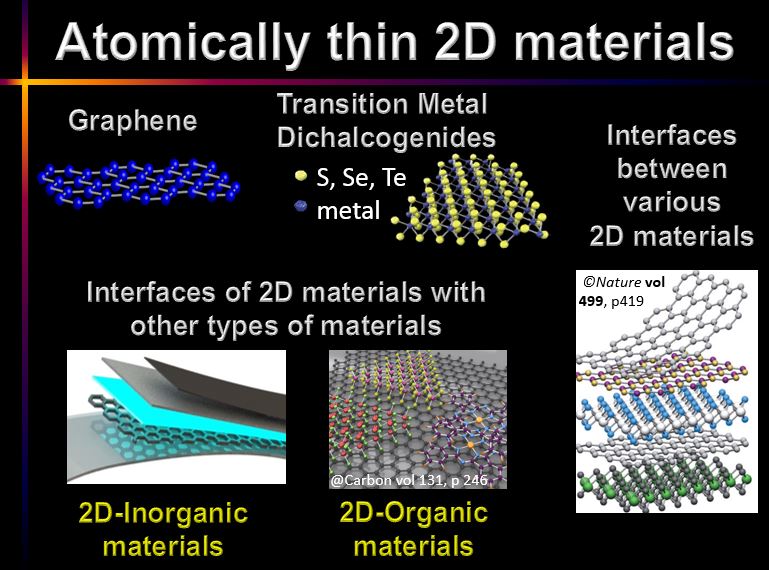
2D materials engineering
We are engineering the 2D materials by chemical functionalization and laser transofrmation to enhance their properties to unprecedented levels. This process can be achived both on large scale or in a selective way using various nano-patterning strategies.
Contributions to this area include novel techniques to pattern electrical circuits in Fluorine- functionalised graphene, of use for whole-graphene electronics [Nano Lett. 11, 3912 (2011)], a method to tailor the band gap of fluorinated graphene by tuning the Fluorine coverage [Nanoscale Res. Lett. 6, 526, (2011) & New J. Phys. 15, 033024 (2013)]. We developed the GraphExeter material (i.e. few-layer graphene intercalated with FeCl3), the best carbon-based transparent conductor [Adv. Mater. 24, 2844 (2012)], with resilience to extreme conditions [Nature Sci. Rep. 5, 7609 (2015)], as well as its laser pattering to define photoactive interfaces. In terms of laser modification of 2D materials, we contributed to the development of a method to accurately produce MoTe2 layers and control their thickness for electronics and optoelectronics [Adv. Funct. Mater. 28 1804434 (2018)]. Our most recent innovation is the development of selective oxidation of 2D materials and of laser-writable high-k dielectric for 2D nanoelectronics [Science Advances 5, eaau0906 (2019)].
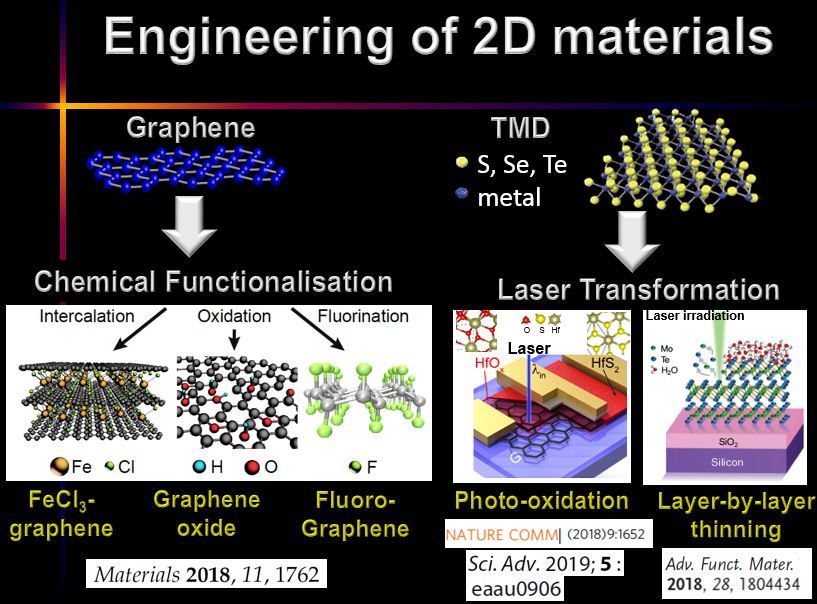
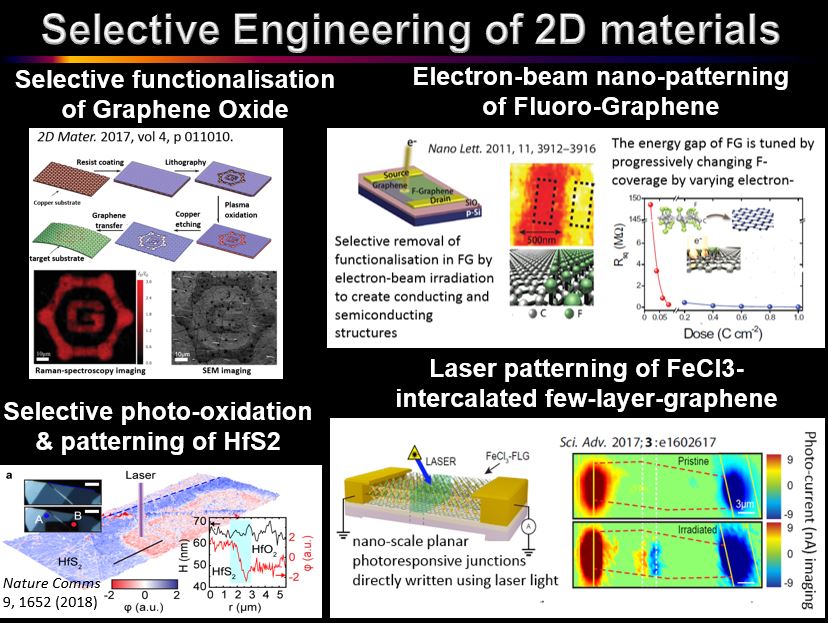
Atomically thin optoelectronic devices
The exploitation of 2D materials with extraordinary performances in optoelectronic devices such as photodetectors, solar cells, light emitting devices is at the heart of this research. In particular, the development of mechanically flexible display and conformable products is an essential step in the effort to develop next-generation opto-electronics technologies.
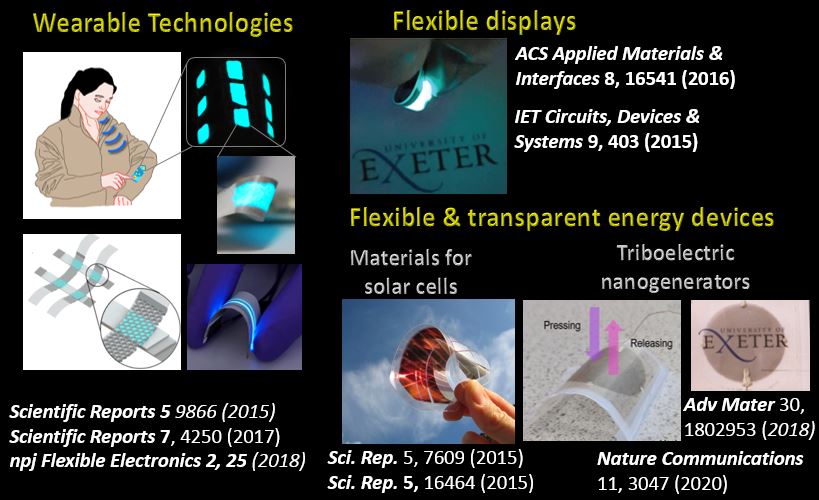 Advances in chemical functionalization have shown that the properties of 2D atomically thin materials can be enhanced to unprecedented levels by chemical functionalization. An example of the potential of chemical functionalization is GraphExeter, a graphene-based material which my team developed at Exeter. In this case, functionalization with FeCl3 of few-layer graphene results in the best transparent electrical conductor which outperforms Indium Tin Oxide used in displays and solar cells. For example, we demonstrated the potential of GraphExeter for flexible and transparent electronics [Nature Sci. Rep. 2015, ACS Nano 2013], wearable electronics, foldable light emitting devices [ACS Appl. Mater. Int. 2016] and solar cells.
Advances in chemical functionalization have shown that the properties of 2D atomically thin materials can be enhanced to unprecedented levels by chemical functionalization. An example of the potential of chemical functionalization is GraphExeter, a graphene-based material which my team developed at Exeter. In this case, functionalization with FeCl3 of few-layer graphene results in the best transparent electrical conductor which outperforms Indium Tin Oxide used in displays and solar cells. For example, we demonstrated the potential of GraphExeter for flexible and transparent electronics [Nature Sci. Rep. 2015, ACS Nano 2013], wearable electronics, foldable light emitting devices [ACS Appl. Mater. Int. 2016] and solar cells.
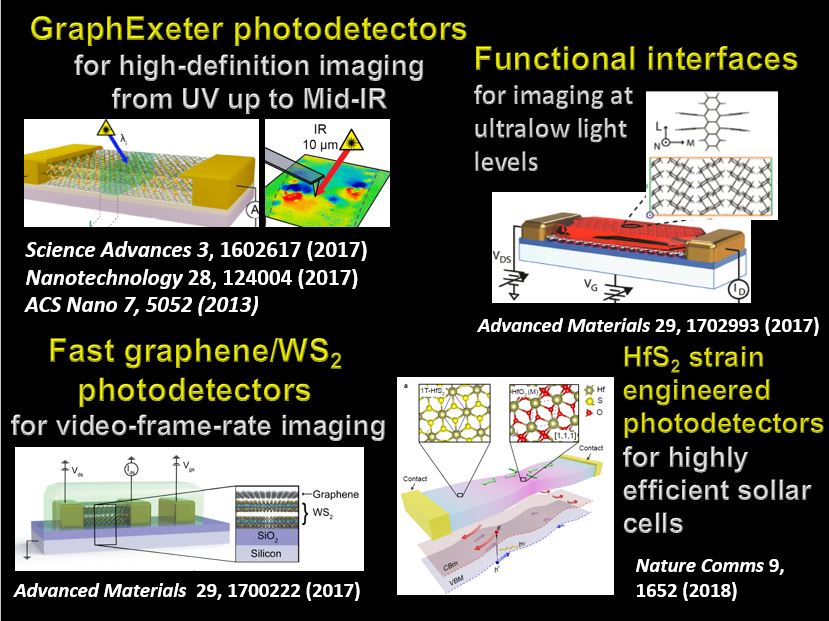
Other advances from our group in this field include photodetectors such as the demonstration of 2D heterostructures for video-frame-rate imaging applications [Adv. Mat. 2017], the intelligent design of 2D devices [Adv. Mat. 2017], engineering of organic-semiconductor-graphene phototransistors amplified imaging at ultralow light levels [Adv. Mat. 2017] and functionalized graphene photodetectors for high-definition sensing and video technologies [Science Advances (2017)]. In the area of photovoltaics we demonstreated the development of the first electron funnel on a chip needed for the next generation of efficient solar cells [Nature Communications (2018)].
Transparent & flexible electronics
The development of optically transparent and mechanically flexible electronic circuitry is an essential step in the effort to develop next-generation electronics technology.
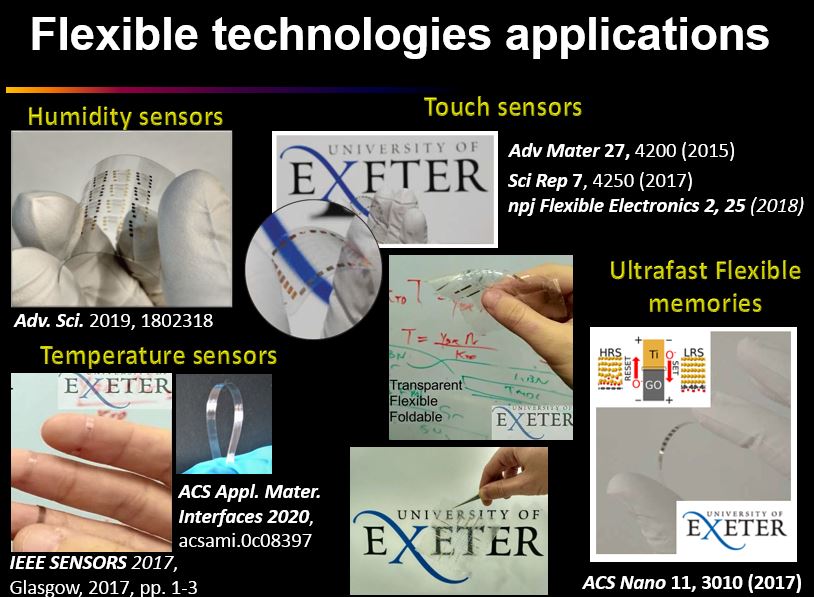
Graphene has a variety of properties which make it an ideal material for such applications: the thinnest, the strongest and yet flexible transparent material, an outstanding electricity and heat conductor with remarkable stiffness and lightness. In particular, graphene is an ideal material for various electronic devices, chemical and biological sensors, and for making the transparent conducting electrical contacts in touch-sensitive screens. Using graphene we have demonstrated graphene-based transparent and flexible touch sensor as well as other types of sensors such as humidity and temperature sensors.
One of the main advantages of 2D materials for various applications is that they can be prepared in form of water-based solutions. The high yield and cost-effectiveness of this method make them of great interest for printed electronics, composites, and bio- and healthcare technologies. Our developments in this area include the integration of high‐quality graphene films obtained from scalable water processing approaches in emerging energy harvesting devices [Adv. Mater. 30, 1802953 (2018)], opening new possibilities for self-powered electronic skin, flexible and wearable electronics. Building on this work, we developed a method for the fabrication of micrometer-sized well-defined patterns in water-based 2D materials [Adv. Sci. 6, 1802318 (2019)]. This method was used to create humidity sensors with performance comparable to that of commercial ones. These sensor devices are fabricated onto a 4 inch polyethylene terephthalate (PET) wafers to create all-graphene humidity sensors that are flexible, transparent, and compatible with current roll-to-roll workflow.
Wearable electronics & smart textiles
We are establishing new technologies for flexible, transparent, comfortable and easy to carry textile-embedded electronic devices. Graphene materials are emerging systems for wearable electronics and smart textiles applications due to their exceptional properties such as electrical conductivity, optical transparency and mechanical flexibility. These properties offer opportunities for the seamless incorporation of electronic devices in textiles, unlocking a future where interacting with electronic devices will be as simple as getting dressed.
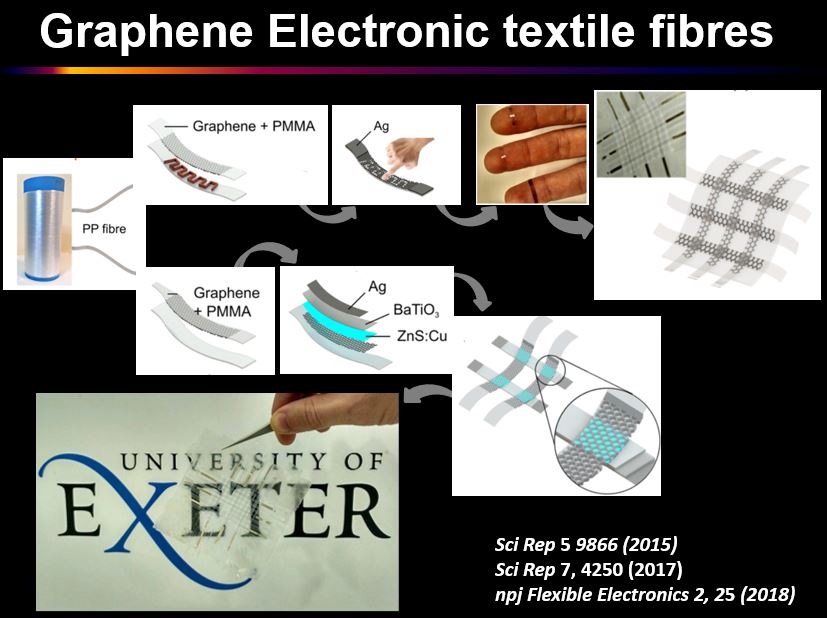 One approach that we follow is to build electronic devices on textile fibres. Our devices combine organic and inorganic semiconductors and dielectrics with graphene as conductive layer, in a novel concept that merges flexibility, transparency, optoelectronic properties and fabrication compatibility of these materials with textiles. All electronic devices need wiring, so the first issue to be addressed is the development of conducting textile fibres which keep the same aspect, comfort and lightness. We have pioneered a new technique to embed transparent, flexible graphene electrodes into fibres commonly used in the textle industry [Nature Sci. Rep. 2015], [Nature Sci Rep. 2017]. The methodology that we have developed to prepare transparent and conductive textile fibres by coating them with graphene has opened a way to the integration of electronic devices on these textile fibres.
One approach that we follow is to build electronic devices on textile fibres. Our devices combine organic and inorganic semiconductors and dielectrics with graphene as conductive layer, in a novel concept that merges flexibility, transparency, optoelectronic properties and fabrication compatibility of these materials with textiles. All electronic devices need wiring, so the first issue to be addressed is the development of conducting textile fibres which keep the same aspect, comfort and lightness. We have pioneered a new technique to embed transparent, flexible graphene electrodes into fibres commonly used in the textle industry [Nature Sci. Rep. 2015], [Nature Sci Rep. 2017]. The methodology that we have developed to prepare transparent and conductive textile fibres by coating them with graphene has opened a way to the integration of electronic devices on these textile fibres.
These graphene-based conductive fibres were used as a platform to build integrated electronic devices directly in textiles. For example, we demonstrated graphene electronic textile fibers that function as touch-sensors and light-emitting devices [npj Flexible Electr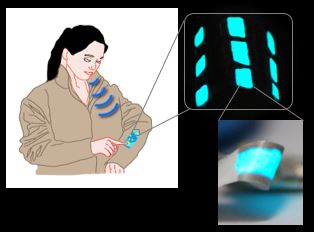 onics 2, 25 (2018)].
onics 2, 25 (2018)].
We also demonstrated the weaving of such graphene electronic fibres in a fabric which enabled the realization of pixels for displays and position sensitive functions. Finally, we recently demonstrated the use of graphene-coated polypropylene (PP) textile fibers as temperature sensors within a low-operating voltage carbon–graphene e-textile system [ACS Appl. Mater. Interfaces 12, 26, 29861 (2020)].
For the development of fabric-based wearable devices, one of the critical challenges is the seamless incorporation of electronics in textiles that will preserve their softness and comfort.
A key feature is the realisation of electrically conductive coatings on textile that conform to the irregular and coarse structures of the textile fabrics. Therefore, a different approach compared to fibers is needed for creating conductive textile fabrics without compromising the properties of the fabric.
We recently demonstrated a simple, low-cost, efficient, and highly scalable method of ultrasonic spray coating for coating three types of textile fabrics, meta-aramid, polyester and nylon, with a water based graphene nanoplatelets suspension [J. Phys. Mater. 4 014004 (2021)]. These conductive textile fabric electrodes show a sheet resistance as low as 4.5 kΩ/sq without any intentional doping or required additives for improved adhesion. Such fabric electrodes have applications in sensors or energy-harvesting wearable technologies.
Quantum Phenomena & Nano electronics
We use nano-electronic devices to investigate the electronic structure of graphene and functionalized graphene materials. Our work spans from fundamental studies in graphene such as Quantum Transport, Quantum Hall Physics and Weak localization studies to applications of these materials in photodetectors, p-n diodes, transistors and resistive memories.
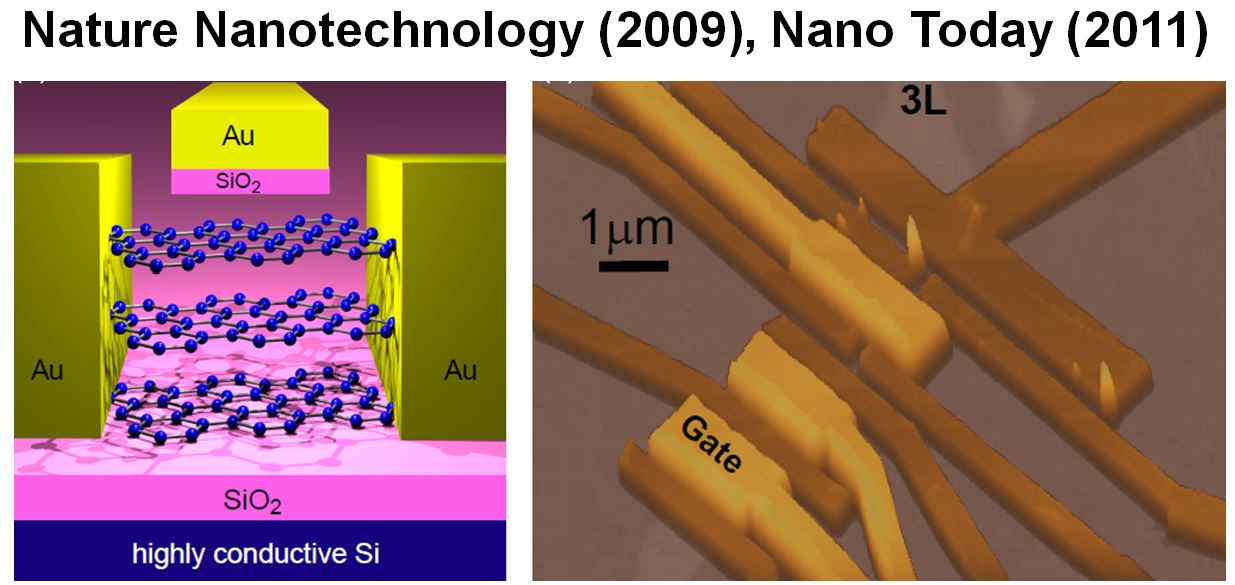
Contributions from our group include the first experimental demonstration of charge carriers propagation in monolayer graphene via evanescent waves [Phys. Rev. Lett. 100, 196802 (2008)] and the discovery that ABA-stacked trilayer graphene is the only gate-tuneable semimetal [Nature Nanotech. 4, 383 (2009)], opening the research area of few-layer graphene (FLG). We also published the first experimental evidence that trilayer graphene has a unique stacking-dependent quantum Hall effect [Phys. Rev. B(R) 84, 161408 (2011)], the first studies of electrical transport in FLG with record high charge densities controlled by liquid ionic gating [PNAS 108, 13002 (2011)], and the first direct observation of the electric field tuneable energy gap in ABC-stacked trilayer graphene [Nano Lett. 15, 4429 (2015)]. Other advances are the realisation of a highly efficient graphene Cooper pair splitter device for quantum information processing [Nature Sci. Rep. 6, 23051 2016], and revealing the mechanism of large distance supercurrent propagation through graphene-superconductor junctions [Nano Lett. 16, 4788 (2016)]. We also developed novel ways to strain graphene [Nano Lett. 14, 1158 (2014)] which were used to experimentally study electron states in uniaxially strained graphene [Nano Lett. 15, 7943 (2015)], of interest for straintronics applications. Recently, we probed different strain configuration in 2D superlattices and provided a new mechanism to induce complex strain patterns in 2D materials [Nano Lett. 18, 7919 (2018)], with profound implications in the development of future electronic devices based on heterostructures
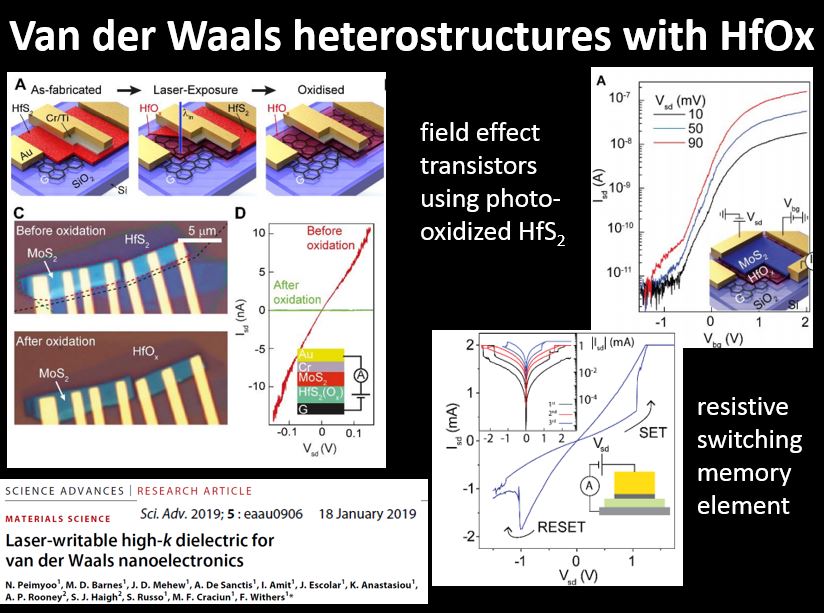
Our most recent advances is the development of laser-writable high-k dielectric for 2D nanoelectronics [Science Advances 5, eaau0906 (2019)].
Similar to silicon-based semiconductor devices, van der Waals heterostructures require integration with high-k oxides. We demonstrated a method to embed and pattern a multifunctional few-nanometer-thick high-k oxide within various van der Waals devices without degrading the properties of the neighboring two-dimensional materials. This transformation allows for the creation of several fundamental nanoelectronic and optoelectronic devices, including flexible Schottky barrier field-effect transistors, dual-gated graphene transistors, and vertical light-emitting/detecting tunneling transistors. Furthermore, upon dielectric breakdown, electrically conductive filaments are formed. This filamentation process can be used to electrically contact encapsulated conductive materials. Careful control of the filamentation process also allows for reversible switching memories.
Open positions
We are always looking for motivated and high-performing summer students, undergraduates (MPhys, BEng, MEng), PhD students (self-funded or as part of our Doctoral Training Centres) and self-funded postdoctoral researchers to be part of our cutting-edge research.I am happy to supervise self-funded PhD students and host in my group self-funded postdoctoral researchers working on any projects related to our currently active research areas.
Please also check out the information about applying for PhD studies in Exeter on our website.
Craciun research news
Conor wins best poster prize at MRE2020
February 2020Congratulations to our PhD student Conor Murphy who won 1st prize for his poster explaining how GraphExeter outperforms Indium tin oxide (ITO) as flexible transparent electrode in OLED.

September 2019
We are very proud of our former PhD student Dimitar Dimov, now CEO of Concrene Ltd for being shortlisted among the 2019 finalists for the Emerging Technologies Competition from Royal Society of Chemistry.
https://twitter.com/RoySocChem/status/1188803996796047361
Adolfo's paper included in the Physics top 50 articles of 2018
July 2019
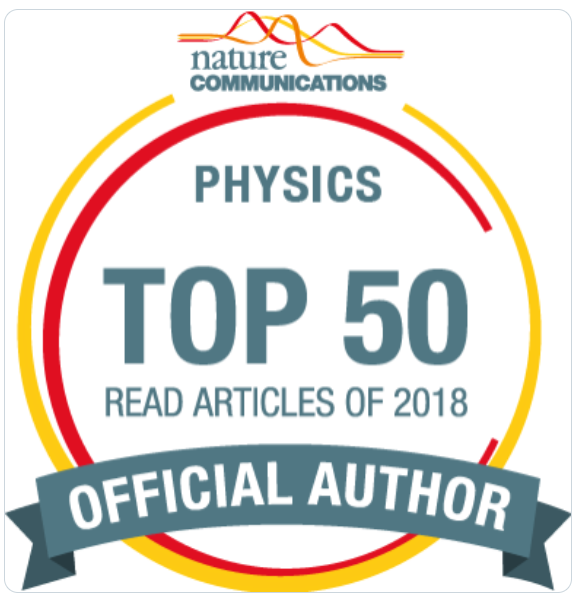
We are proud to be in the Top 50 Physics most read articles in Nature Communications
with our paper: Strain-engineered inverse charge-funnelling in layered semiconductors.
The work was done in collaboration with a brilliant group from Russo and Craciun labs.
Read the paper here
Monica Craciun and Dimitar Dimov delivered a TEDx talk
October 2018
Monica gave an overview of the wide gamut of potential emerging technologies enabled by graphene and Dimitar spoke about the potential of graphene in reducing CO2 emissions due to concrete.
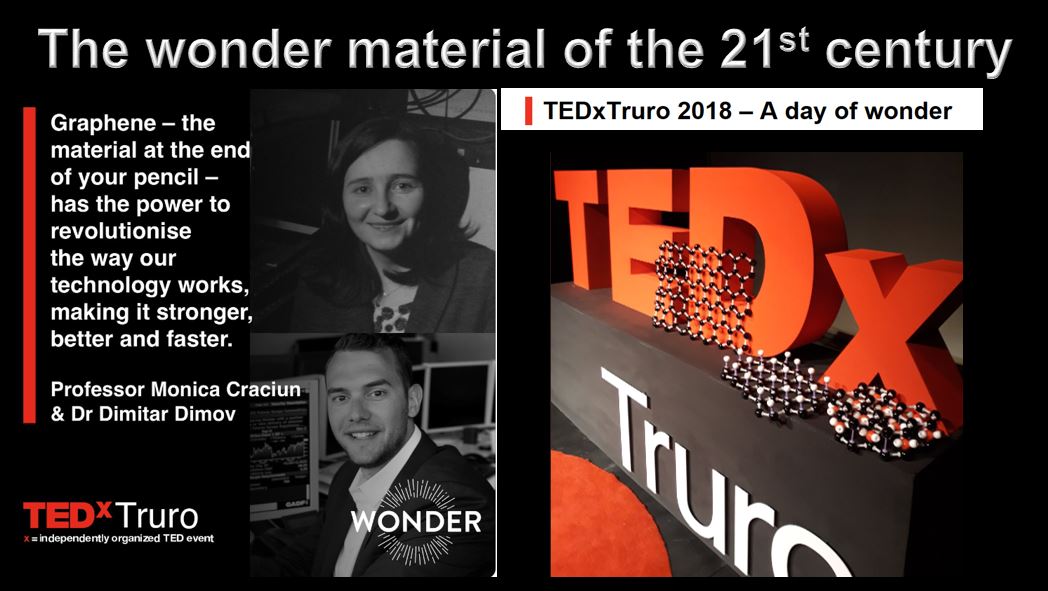
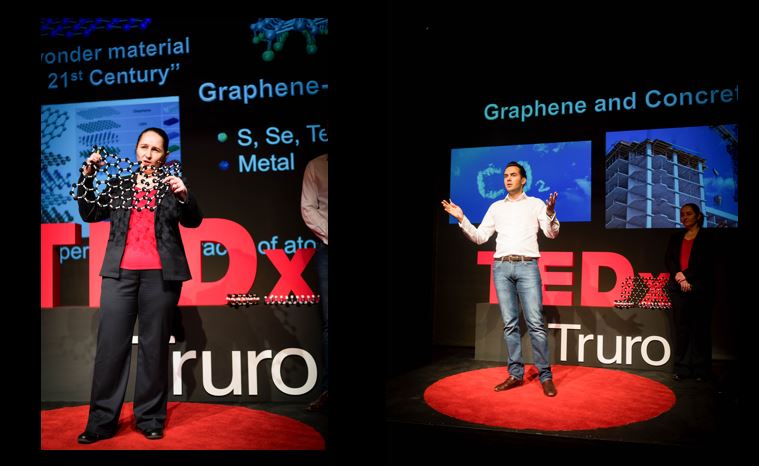
Gopika Rajan participates in the Soapbox Science event in Exeter
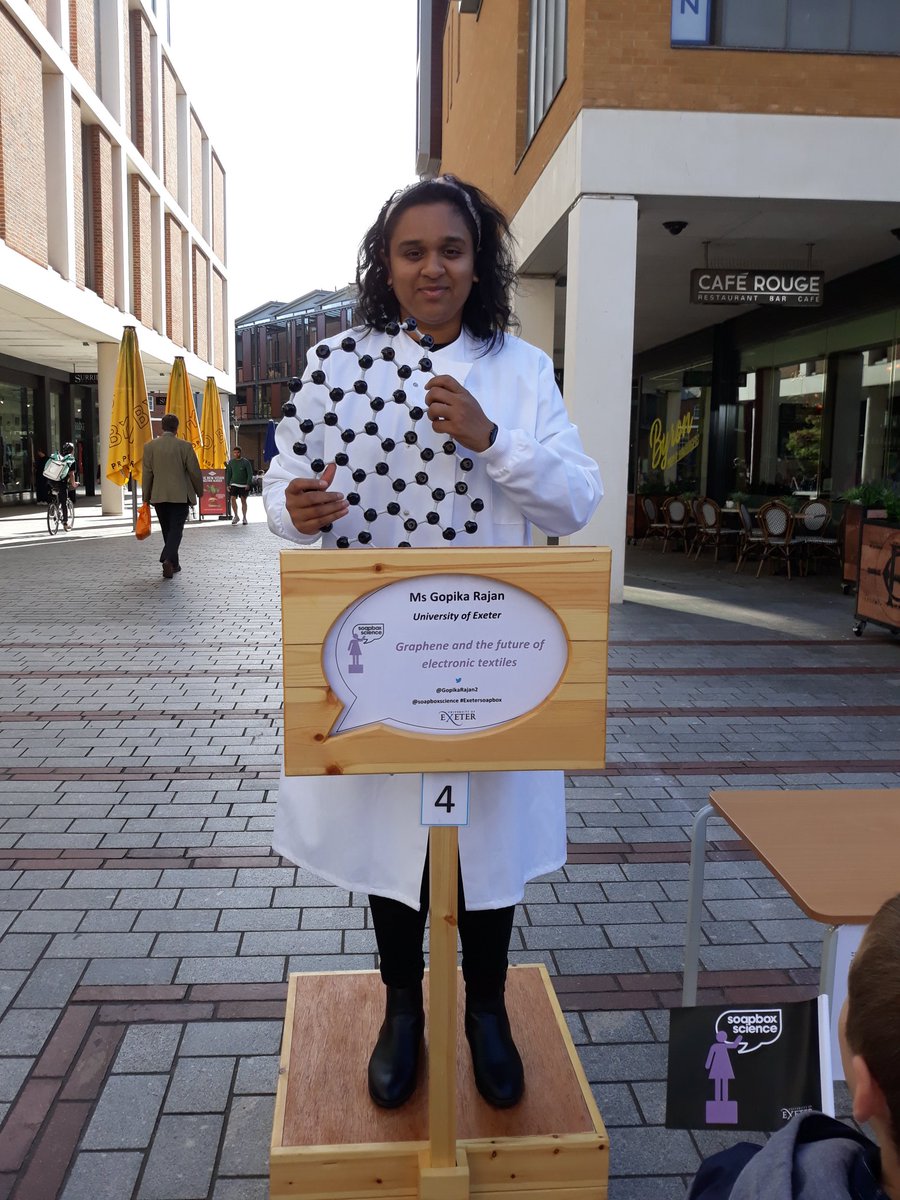
September 2018
This year our PhD student Gopika Rajan has been talking about graphene and electronic textile at the Exeter 2018 ExeterSoapbox event. This was a very successful SoapboxScience with more than 4000 people attending.
Graphene reinforced concrete shortlisted at the New Civil Engineer’s Techfest 2018
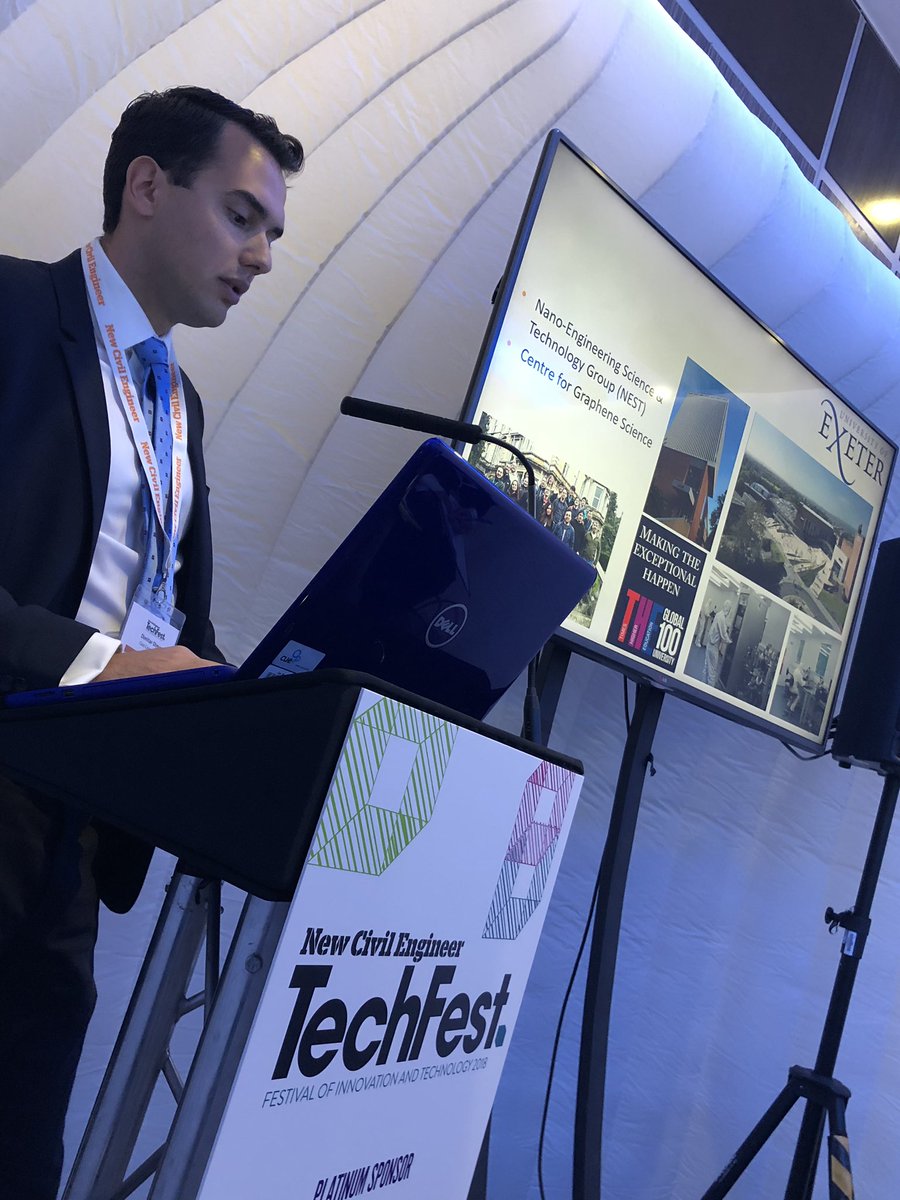 September 2018
September 2018
We are proud to be shortlisted for 2 categories at this year’s NCETechFest - competing with the best innovators in the UK construction industry. Dimitar has presented our work at "Best Use of Technology: Carbon Reduction" category and "Research Development: Creating the Future category".
Janire wins the best poster prize at Trends in Nanotechnology 2018 conference
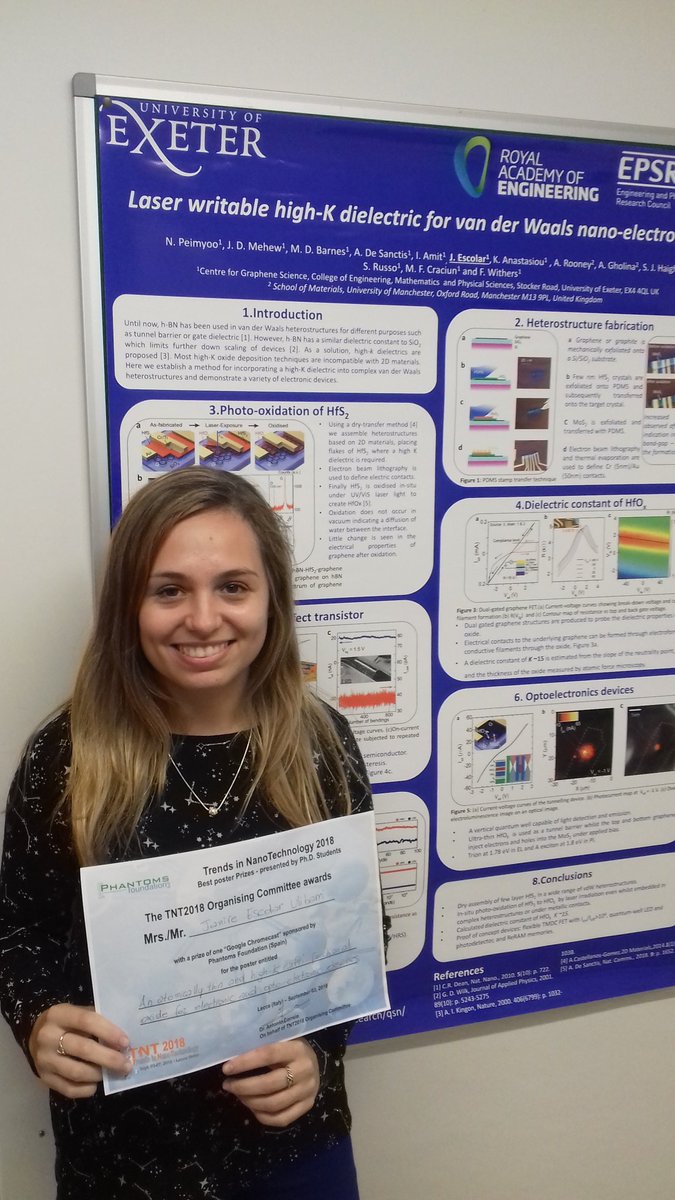
September 2018
Congratulations to our PhD student Janire Escolar for winning the best poster prize at the Trends in Nanotechnology 2018 (Lecce, Italy) with her poster on laser writable high-k dielectric for nanoelectronics.
Congratulations to Dr Matt Barnes for receiving his PhD award
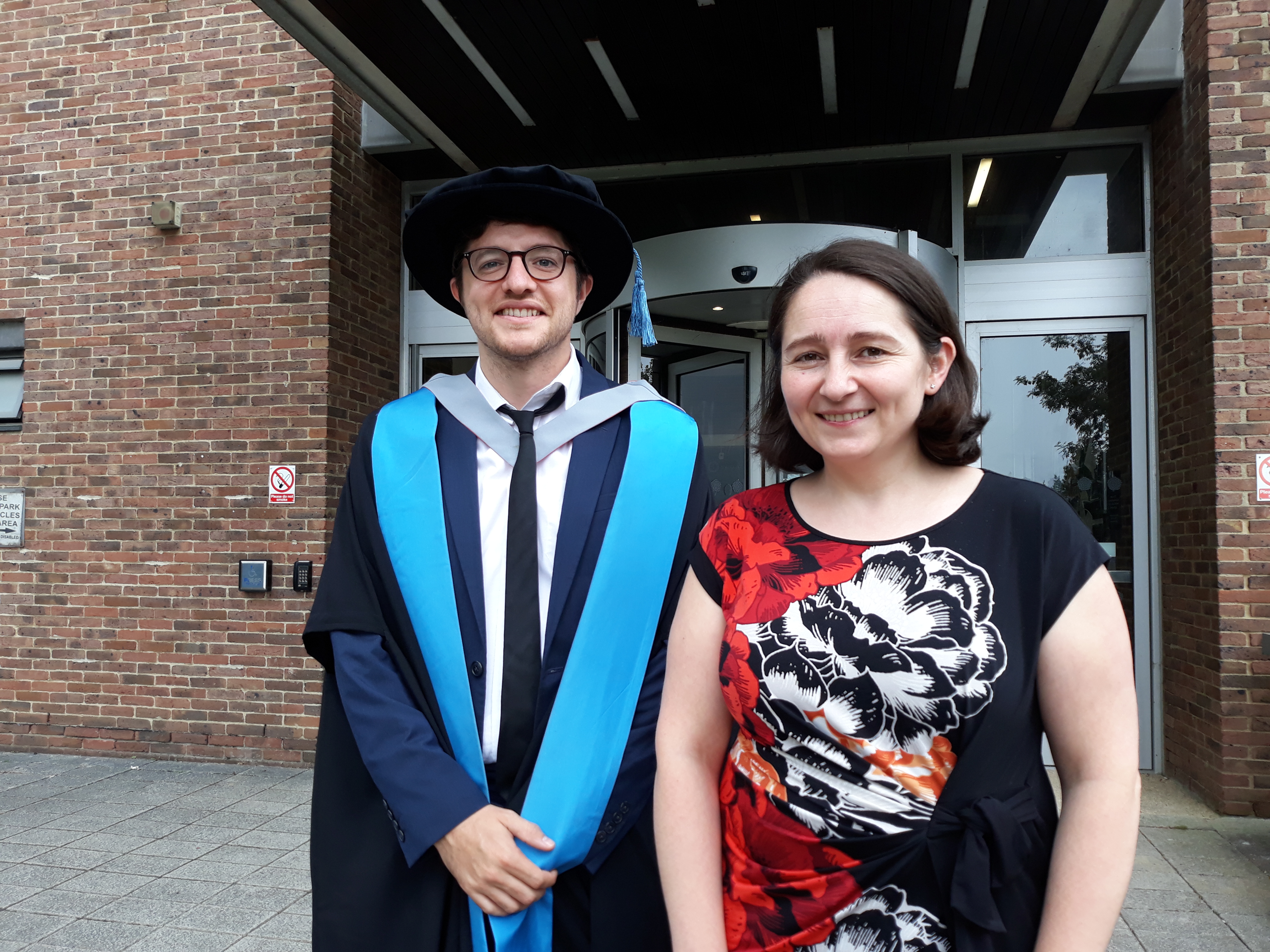
July 2018
Matt has succesfully defended his thesis titled "Growth and Oxidation of Graphene and Two-Dimensional Materials for Flexible Electronic Applications". During his PhD work, Matt has published many papers in world leading peer reviewed scientific journals including Science Advances, ACS Nano and Advanced Materials.
Dimitar Dimov on the BBC Radio 5 live science about our graphene-concrete composite
May 2018
Listen to our PhD student Dimitar Dimov who spoke on the BBC Radio 5 live science about our work on nanoengineering traditional concrete with graphene. See the BBC Radio 5 live science podcast. https://www.bbc.co.uk/programmes/b0b0rvf5 …
Graphene 'a game-changer' in making building with concrete greener
May 2018
The Guardian reports on our work on the incorporation of graphene in concrete.
Innovative new ‘green’ concrete using graphene
We developed a new greener, stronger and more durable concrete that is made using the wonder-material graphene could revolutionise the construction industry
New devices for imaging at ultralow light levels
We have engineered organic-semiconductor–graphene phototransistors which are spectrally selective to visible wavelengths and have record high responsivity and a detectivity. Such devices pave the way for the implementation of low-cost, flexible imaging technologies at ultralow light levels. This study was published in Advanced Materials (2017).
Graphene variants promise new possibilities
News story on our research group was covered in IoP nanotechweb.org
http://nanotechweb.org/cws/article/tech/70008
New technique could revolutionise manufacturing of vital safety equipment
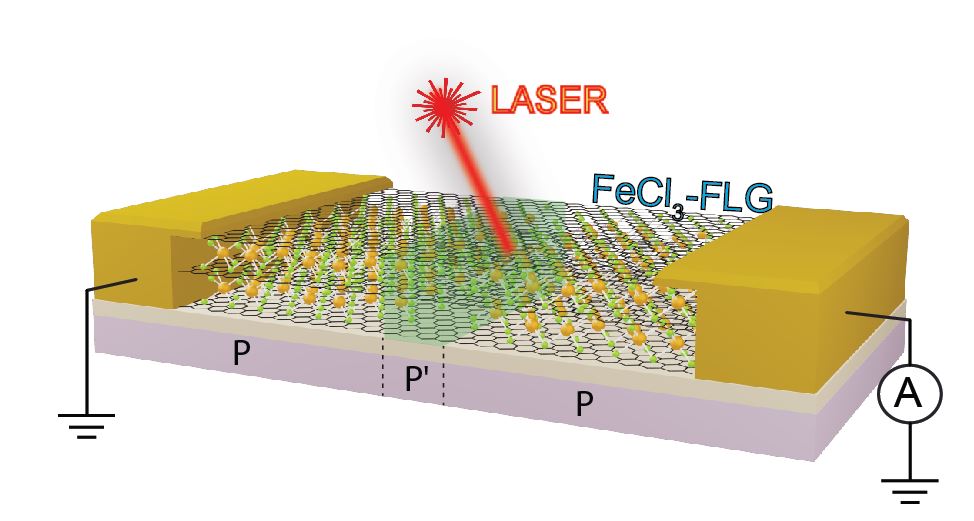
We demonstrated an innovative new technique to use graphene to produce the ultimate photodetectors that could revolutionise the manufacturing of vital safety equipment, such as radiation and smoke detection units. In this study, published in [Science Advances (2017)], we created a new type of photodetector based on GraphExeter that can sense light around 4500 times better than traditional graphene sensors. The discovery could herald a new generation of sensoring and imaging equipment that is more stable in harsh conditions, as well as been smaller and most cost-effective
Congratulations to Dr Adolfo De Sanctis for receiving his PhD award
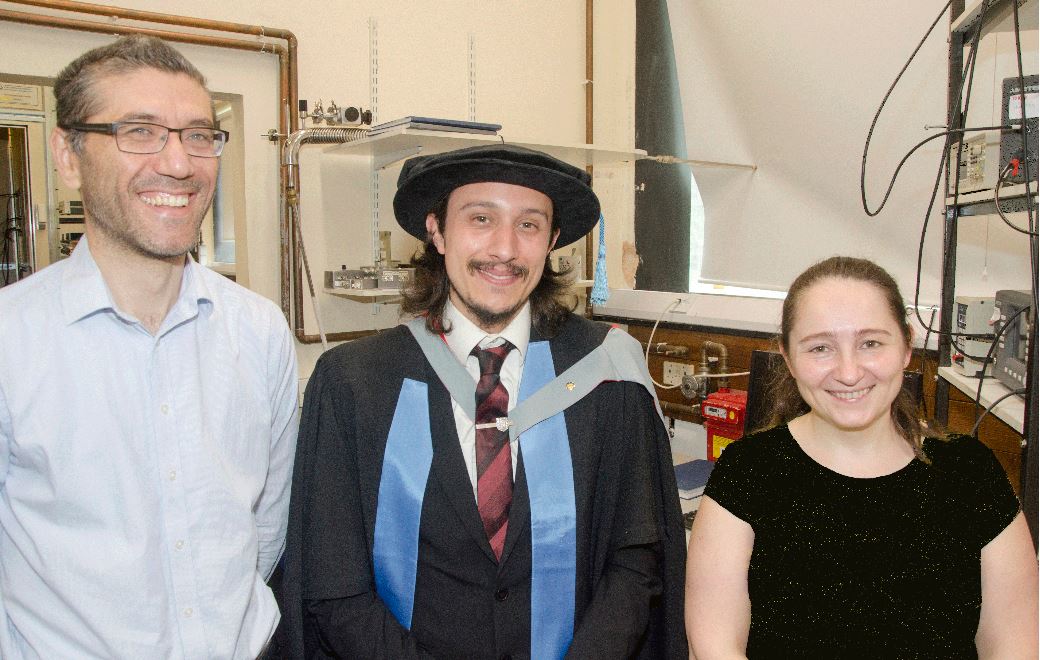
July 2017
Adolfo has succesfully defended his thesis titled "Manipulating light in two-dimensional layered materials". During the 3 years of his PhD work, Adolfo has published 7 papers in world leading peer reviewed scientific journals including Science Advances, Nano Letters and Advanced Materials.
GraphExeter, one of the nanotechnology highlights of 2016
January 2017
Our recent developments of GraphExeter material for highly efficient flexible displays has been selected by the IoP nanotechnology website as one of the "Highlights of 2016” . Our work features under the most important advancements in electronics and photonics in 2016, alongside with IBM's developments in neuromorphic computing.
http://nanotechweb.org/cws/article/tech/65654
Ground-breaking production method could accelerate worldwide ‘graphene revolution’
We have developed an innovative new cheap and simple mass production technique, which is set to open up the global potential of the ‘wonder’ material graphene.
GraphExeter illuminates bright new future for flexible lighting devices
August 2016
We have pioneered an innovative new technique to make flexible screens more effective and efficient.
Our team discovered that GraphExeter – a material adapted from the ‘wonder material’ graphene - can substantially improve the effectiveness of large, flat, flexible lighting.
https://www.youtube.com/watch?v=ks6EkNsM4TA&feature=youtu.be
Congratulations to Dr Tom Bointon for receiving his PhD award
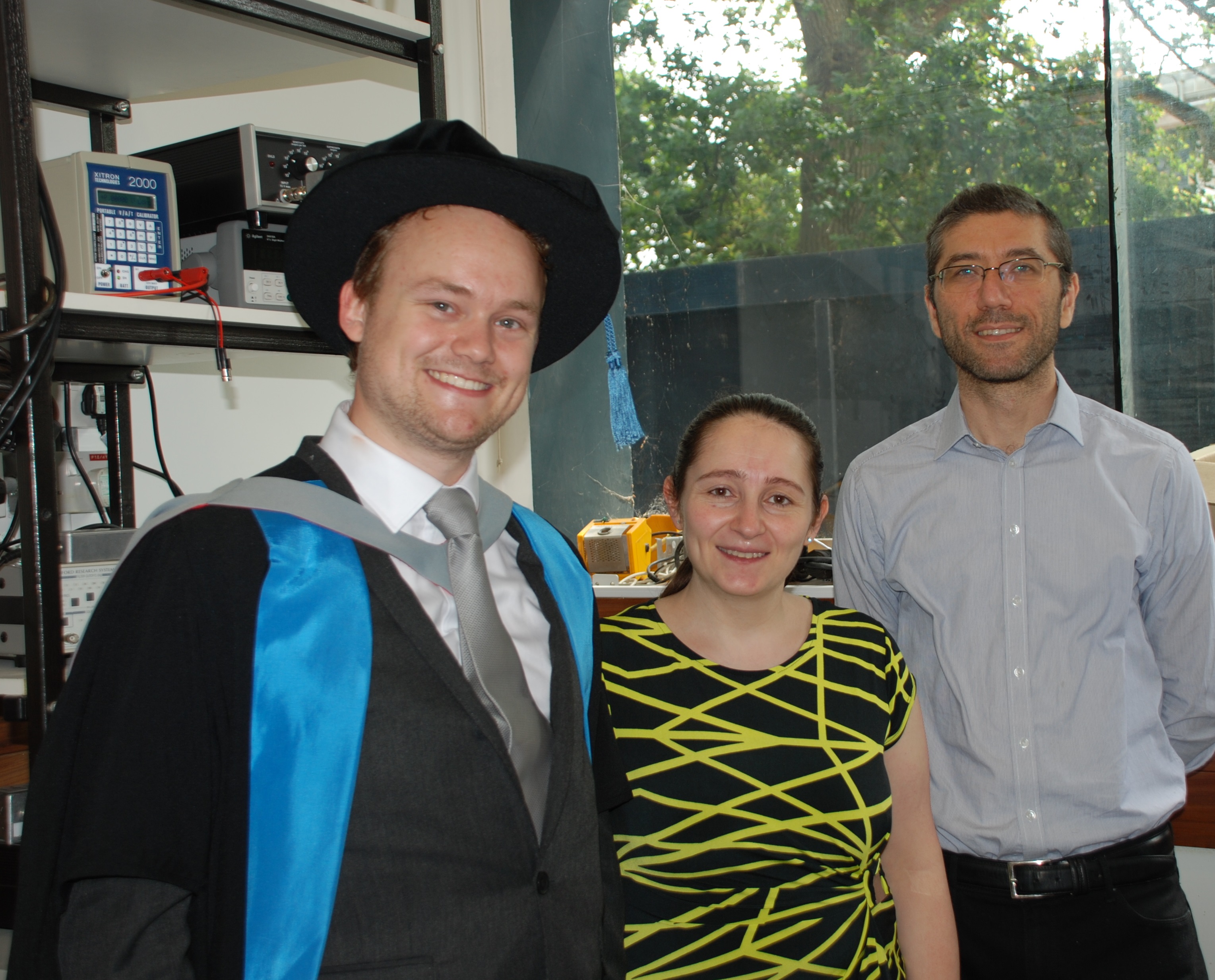 July 2015
July 2015
Tom has succesfully defended his thesis titled "Graphene and functionalised graphene for flexible and optoelectric applications". During the 3 years that he has worked in our group, Tom has published 10 papers in world leading peer reviewed scientific journals including 2 Nano Letters, 1 ACS Nano and 2 Advanced Materials.
Breakthrough in graphene production could trigger revolution in artificial skin development
Phys.Org: Breakthrough in graphene production
Novel graphene production method by Exeter could trigger revolution in artificial skin development
Congratulations to Dimitar Dimov for wining this year's Philip Booth Prize in Engineering!
June 2015
Our BEng studnet Dimitar Dimov has won the 2015 Philip Booth Prize in Engineering for his final year indvidual project work on graphene reinforced concrete. This prize is awarded to a stage 3 BEng/MEng for the best individual project in Engineering.
Dr Ana Neves participates in the Soapbox Science event in Exeter
June 2015
During her spell on the soapbox, Dr Ana Neves amazed the audience with the possibilities of smart textiles and her research into building electronic devices directly onto textile fibres, posing the question, “What if you could make a phone call using your sweater instead of your mobile?”
Graphene holds key to unlocking creation of wearable electronic devices
The World's First Electronic Fabric?
‘Truly’ electronic textile made of graphene for wearable tech
Now, wearable electronic devices, thanks to graphene
GraphExeter defies the Achilles heel of wonder material graphene
Science Daily: Defying the Achilles heel of 'wonder material' graphene: Resilience to extreme conditions
ElMundo: 'Supergrafeno' ultrarresistente

BBC: Exeter scientists make 'electric cloth' GraphExeter
Forbes: Researchers Invent Smallest And Thinnest Microconductor
Reuters: WIRED FOR SOUND
Technology Strategy Board news: The invisible conductor
Plastic Electronics: UK research advances graphene as transparent conductor
Plastic Electronics:University of Exeter researchers develop graphene photoelectric device
Science Daily: Wearable electronics:Transparent, lightweight, flexible conductor could revolutionize electronics industry
IEEE Spectrum: Inventors Claim Graphene Hybrid Could Revolutionize Electronics Industry
Phys.Org: Graphene and graphExeter combine to create a new flexible, transparent, photosensitive device
Solar Novus Today: Will GraphExeter Revolutionise Wearable Electronics?
New Electronics: Graphene based material to revolutionise electronics industry
Nature Asia Materials: Stacking three sheets of graphene together yields a material with unique electronic properties
Highlights of our research in scientific journals
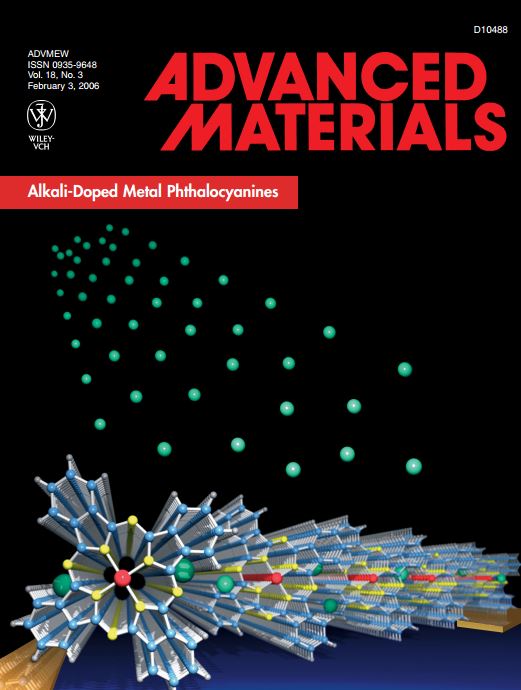
The article: Electronic transport through electron-doped metal phthalocyanines
materials by M. F. Craciun et al., published in Advanced Materials 18, 320 (2006)
has been featured on the cover of the journal.
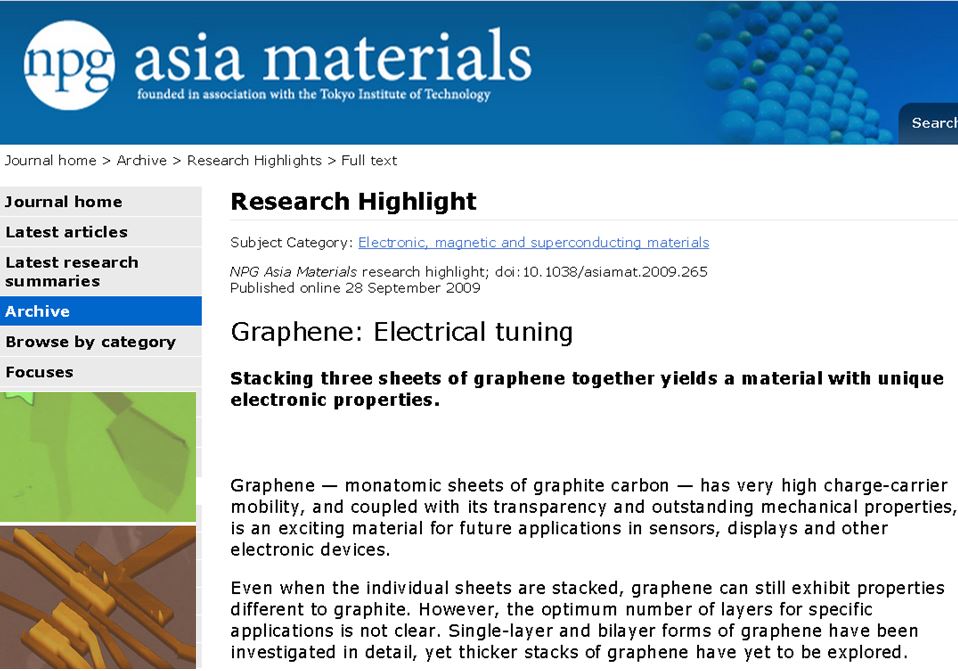
The paper "Trilayer graphene is a semimetal with a gate-tunable band overlap" by M.F.Craciun at al., published in Nature Nanotech. 4, 383 (2009) has been highlighted in the news of Nature Asia Materials.
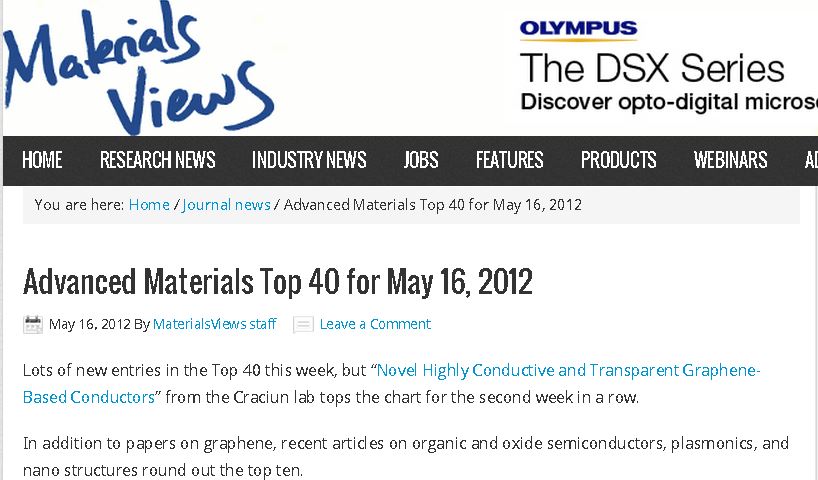
The article [Adv. Mater. 24, 2844 (2012)] has been the most downloaded article of the journal and has been featured on the first position in the Advanced Materials Top 40 charts in 2012.
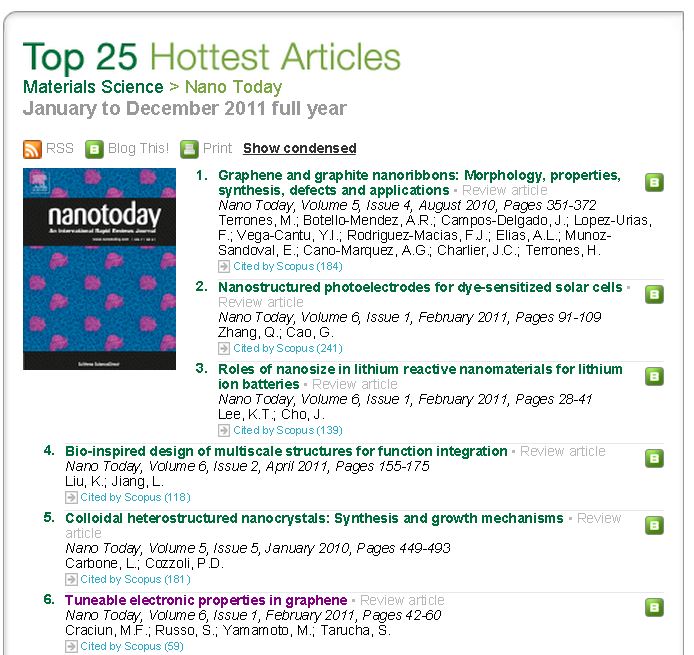
The review Tuneable electronic properties in graphene by M.F.Craciun et al., published in Nano Today, 6, 42 (2011) has been featured in the Science Direct Top 25 Hottest Articles of the year.
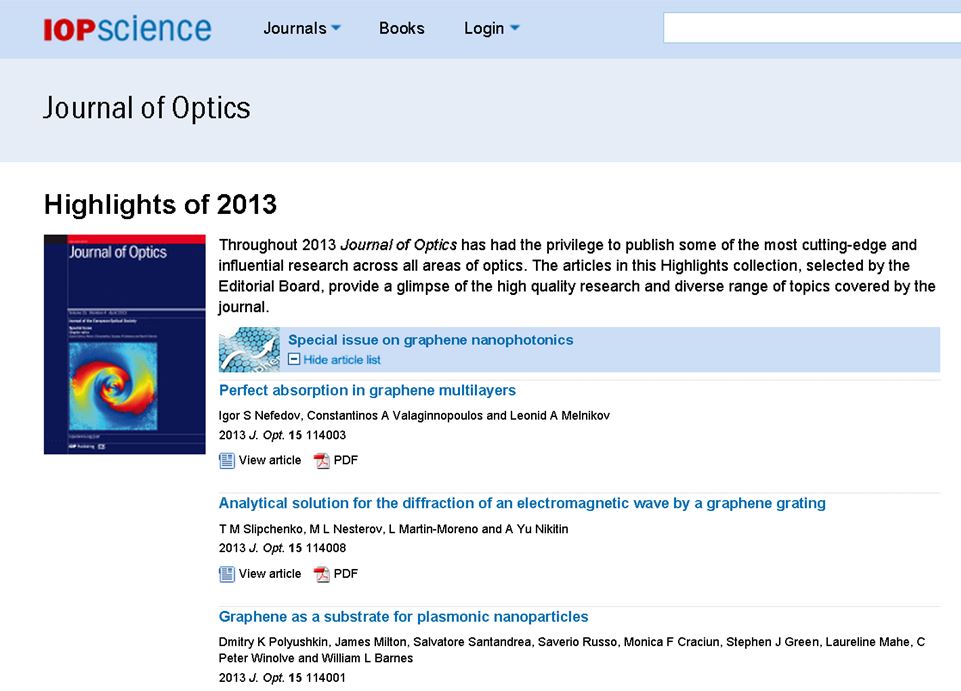
The article "Graphene as a substrate for plasmonic nanoparticles [J. Opt. 15, 114001 (2013)] has been selected by the editors of Journal of Optics as a Highlight of 2013.
Innovation and Impact
Our research on 2D materials at Exeter has gained recognition beyond the academic community in various areas.
We are constantly exploring the commercial potential of emergent research conducted by our group at the University of Exeter. This research has the capacity to reduce the cost and radically enhance the electrical, optical and mechanical properties of a wide range of products spanning a broad spectrum of industrial activity.
Various members of our team are exploring business cases for solutions that include; Patented conductive films that overcome the limitations of other materials; Conductive inks that meet the demands of the emerging flexible electronics industry; Nano Additives that can enhance the physical properties of composite materials.
Nanoengineered building materials
In the field of nanoengineered building materials, our group has developed a new graphene/concrete composite with an unprecedented range of enhanced and multifunctional properties compared to standard concrete Managing the environmental impact of mankind is a major challenge which sees the concrete industry being one of the main key contributor to the global greenhouse emissions. In addition, the urbanization of areas subject to major environmental risks, e.g. flooding and earth quakes, poses strict demands on resilient construction materials, which should ideally be easily accessible. Our research on graphene reinforced concrete underpins all these key aspects.
Concrene Limited is a spin-off company from the University of Exeter, that introduces an innovative and patented type of concrete to the construction industry. For more details please see: https://www.concrene.com/
Graphene commercialization
Our group is commercializing graphene and GraphExeter materials and devices
For more information please contact:
Prof Monica Craciun: m.f.craciun@exeter.ac.uk
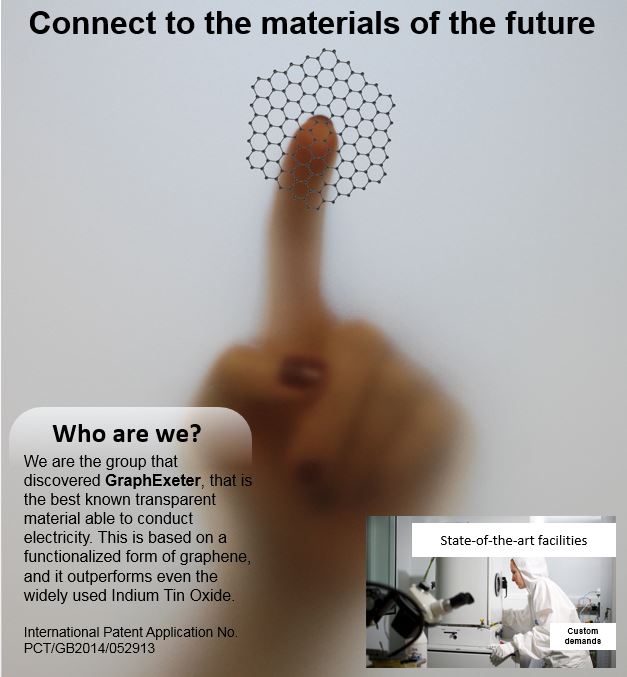
GraphExeter (FeCl3 intercalated few-layer graphene) is the best transparent conductive material (Adv. Mater. 24, 2844 (2012)).
Exceptional properties:
>87% Transparency: 400 nm to 850 nm
-Mechanical flexibility: stable to >2000 bendings
-Resistance to 100% humidity
-Resistance at extreme temperatures: from 300 mK to 873 K (Sci. Rep. 5, 7609 (2015))
-Can sustain >10 times larger current than metals
International patents:
“Graphene-based material” : KR20140095614 (A)
“Graphene-based material” : US2014174513 (A1)
“Detector”: WO2014111702 (A2)
Monolayer CVD graphene grown on copper foil
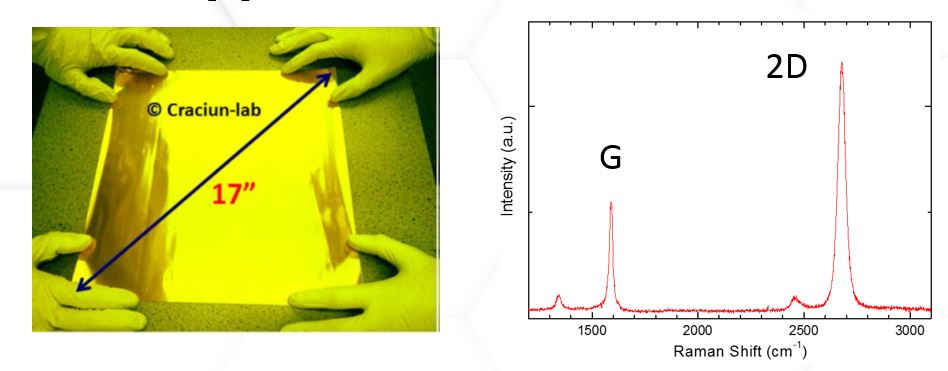
Sizes up to 17" in diagonal
Product characteristics:
- Monolayer 99% of the surface area
- Coverage 100%
- Grain size typically 30 μm
Substrates:
-Standard semi-conductors
-Quartz/glass
-Transparent polymers: PTFE, PEN, PDMS
Devices:
-Graphene MEMS and NEMS (nano- and micro-mechanical devices)
- Invisible pressure sensors
- Ring-shaped transistors
- Plasmonic arrays of nanoribbons
Custom designsWe are happy to produce custom graphene structures and devices with nanometer-scale accuracy. Contact us to discuss your requirements. Examples of the structures that we can produce include:
-High frequency graphene transistors
-Graphene Hall bars
-Superconducting nanostructures
-Graphene plasmonic arrays
Also available: Graphene and GraphExeter inks for printed electronics and conductive coatings Scientific advisors:Prof Monica Craciun Prof Saverio Russo
+ 44(0) 1392 723656 + 44 (0) 1392 725195
M.F.Craciun@exeter.ac.uk s.russo@exeter.ac.uk
We are seeking partners to help develop and commercialise the GraphExeter technology.We are happy to discuss collaborative opportunities or are willing to license the technology to suitable commercial partners.
Craciun research group - former members
Research Fellows (fellowship holders)- Dr Rosanna Mastria Marie Curie Fellow (Physics, co-host, joint with Prof Saverio Russo)
-
Dr Ana Neves (Engineering), Marie Curie Individual Fellowship: 2016-2018
- project: E-TEX (All-organic devices in textiles for wearable electronics)
- present position: Senior Lecturer in Materials Engineering at the University of Exeter
-
Dr Iddo Amit (Physics, co-host with Prof Saverio Russo), Marie Curie Individual Fellowship: 2016-2018
- project: FLAIR (Flexible Hyperspectral Infrared Detectors)
- present position: Assitant Professor in Engineering at Durham University
-
Dr Freddie Withers, (Engineering) Royal Academy of Engineering Research Fellowship: 2013-2018
- project: Light harvesting hybrid – graphene based devices (GrapheX)
- present position: Lecturer in Physics at the University of Exeter
-
Dr Liping Lu (Physics, co-host with Prof Saverio Russo), Royal Academy of Engineering Enterprise Fellowship: 2018
- project: Graphexe Nanotechnology
- present position: Associate Research Fellow at the University of Exeter
- Dr Adolfo De-Sanctis (Physics, joint with Prof Saverio Russo), now at Crossfield Fusion ltd
- Dr Peimyoo Namphung (Engineering, 2016-2019), now Postdoctoral Research Associate at Imperial College London
- Dr Shin Dong-Wook (Engineering 2016-2019), now Research Associate in Quantum Dot Display Technology at Cambridge University, UK
- Dr Iddo Amit (Engineering, 2015), now Assitant Professor in Engineering at Durham University
- Dr Karthik Nagareddy (Engineering, joint with Prof David Wright)
- Dr Liping Lu (Engineering 2015-2018)
- Dr Arseny Alexeev (Engineering, joint with Prof David Wright and Dr Mustafa Aziz), now Senior Manager, Waveguide Development at WaveOptics
- Dr Laureline Mahe (Postdoc, Physics, joint with Prof Saverio Russo), 2014-2015, now Senior Consultant Applied Scientist at Team Consulting
- Dr Dominique Wehenkel (Postdoc, Physics) 2013-2014, now Application Scientist at Applied Nanolayers
- Dr Peng Tian (Physics, joint with Prof Saverio Russo), now Experimental Officer at The University of Manchester
- Dr Ana Neves (Engineering: 2014-2016)
- Dr Iddo Amit (Engineering: 2015-2016)
- Dr Freddie Withers, (Engineering: 2012-2013, 2018)
- Dr Kavya Sreeja Sadanandan (Engineering 2023, Metamaterials CDT)
- Dr Jonas Riisnaes (Physics 2023, Metamaterials CDT)
- Dr Konstantinous Anastasiou (Physics 2022, Metamaterials CDT)
- Dr Agnes Bacon Physics 2022,
- Dr Connor Murphy (Engineering 2022, Metamaterials CDT)
-
Dr Gopika Rajan (Engineering 2021)
- PhD thesis: Graphene-based textile fibre sensors.
- Dr Kieran Walsh (Engineering 2021, Metamaterials CDT)
- Dr Joe Morgan (Engineering,Metamaterials CDT, joint with Prof Steve Eichhorn and Prof Yanqiu Zhu): 2020
- Dr Janire Escolar (Physics, Quantum Systems and Nanomaterials, joint with Prof Saverio Russo): 2020
-
Dr Jake Mehew (Physics, Metamaterials CDT, joint with Prof Saverio Russo): 2019
- PhD thesis: Optoelectronic devices based on van der Waals heterostructures
- present position: Postdoctoral Researcher, Institut Català de Nanociència i Nanotecnologia (ICN2)
- Dr Tobias Octon (Engineering, Metamaterials CDT, joint with Prof David Wright): 2019
-
Dr Nicola Townsend (DSTL-funded, Physics, Quantum Systems and Nanomaterials, joint with Prof Saverio Russo): 2019
- PhD thesis: Conductance impedance effects in atomically thin semiconductors
- present position: Research Associate at Durham University
-
Dr Ben Hogan (Engineering,Metamaterials CDT, joint with Dr Anna Baldycheva): 2019
- PhD Thesis: Fluid-Dispersed 2D Material Composites for Integrated Optoelectronic and Photonic Devices
- present position: Postdoctoral Researcher at University of Oulu, Finland
-
Dr Dimitar Dimov (Engineering, Functional Materials, joint with Prof Saverio Russo): 2018
- PhD thesis: Fundamental physical properties of graphene reinforced concrete.
- present position: Founder & CEO of Concrene Ltd, and Data Analyst at Laing O'Rourke
-
Dr Alkhalifa Saad Fadhil Ramadhan (Physics, Quantum Systems and Nanomaterials, joint with Prof Saverio Russo): 2018
- PhD thesis: 2D materials for Magnetic and Optoelectronic Sensing Applications
- present position: Lecturer in Physics at University of Duhok
-
Dr Elias Torres Alonso (Engineering, Functional Materials, joint with Prof Saverio Russo): 2018
- PhD thesis: Scalable processing and integration of 2D materials and devices
- present position: Head of foundry at Graphenea
-
Dr Matt Barnes (Engineering, Functional Materials, joint with Prof David Wright), 2017
- PhD thesis: Growth and Oxidation of Graphene and Two-Dimensional Materials for Flexible Electronic Applications.
- present position: now at Applied Nanolayers
-
Dr Gareth Jones (Physics, Quantum Systems and Nanomaterials, joint with Prof Saverio Russo), 2017
- PhD thesis: Modification of Graphene for Applications in Optoelectronics
- present position: Scientific and Technical Officer at University of Manchester
-
Dr Adolfo De-Sanctis (Physics, joint with Prof Saverio Russo), 2017
- PhD thesis: Manipulating light in two-dimensional layered materials
- present position: Crossfield Fusion ltd
-
Dr Tobias Bachmann (Engineering, Functional Materials, joint with Prof David Wright and Dr David Horsell), 2017
- PhD thesis: Nanoscale Carbon-Based Memory Devices
- Dr Selim Unal (PhD Physics, joint with Prof Saverio Russo), 2017
-
Dr Tom Bointon (PhD, Engineering), 2015.
- PhD thesis: Graphene and functionalised graphene for flexible and optoelectric applications
- present position: Technical Director, Henniker Plasma
-
Dr Freddie Withers, (PhD Physics), 2012
- PhD thesis: Chemical Modification of graphene
- present position: Lecturer in Physics at the University of Exeter
- Mukond Khetani (MPhyl, Physics, joint with Prof Saverio Russo), Knowledge Transfer Partnership Associate with Spinnaker
- James Milton (Physics,Quantum Systems and Nanomaterials, joint with Prof David Wright)
- Emily Hacking, MEng Civil Engineering
- Jarvis Devon, MEng Civil Engineering
- Kyra Wilson, MEng Civil Engineering
- Alexander Foy, MEng Civil Engineering
- Chun Yong Koh, MEng Mechanical Engineering
- Naufal Ismadi, MEng Materials Engineering
- Peter Kenmir, MEng Materials Engineering
- Daniel Corcuera-Robbins, MEng Materials Engineering
- James Turner, MEng Materials Engineering
- Hannah Carney, MEng Materials Engineering
- Henry Hyde, MEng Materials Engineering
- James Osborn, MEng Materials Engineering
- Joe McSloy, BEng Mechanical Engineering
- William Rees, MEng Materials Engineering
- Rachael Quintin-Baxendale, MEng Mechanical Engineering
- Jonathan Elliott, MEng Materials Engineering
- Russell Rianna, MEng Materials Engineering
- Zhong Joseph, MEng Materials Engineering
- Iluyemi Dashe, MEng Materials Engineering
- Tanner Edward, MEng Materials Engineering
- Ukata Chinazam, MEng Materials Engineering
- Harry Kavita, BEng Materials Engineering
- Eastlund Samuel, MEng Electronic Engineering
- Mayfield Tom, MEng Electronic Engineering
- Dobson Ruth, MEng Civil Engineering
- Koh Chun, MEng Mechanical Engineering
- Chalkley Elliot, MEng Electronic Engineering
- Abdelmoneim Dewidar, MEng Electronic Engineering
- Jonathan James Elliott, BEng Materials Engineering
- Ellen Liu, Msc Materials Engineering
- Robert Skipworth, MEng Mechanical Engineering, 2017-2018
- Shayar Solanki, MEng Mechanical Engineering, 2017-2018
- Edward Stringer, BEng Civil Engineering, 2017-2018, 2017-2018
- Kennard Aditya Wardana, BEng Materials Engineering, 2017-2018
- Girthanaah Karunanithy, BEng Materials Engineering, 2017-2018
- Colenso Christopher, MEng Mechanical Engineering, 2016-2017
- Gorrie Olivier, BEng Mechanical Engineering, 2016-2017
- Isabel Kiyomoto Arteaga, MPhys, 2016-2017
- Alasdair Purves, MPhys, 2016-2017
- Yarrow-Jenkins James, MPhys, 2016-2017
- Cornell Bethan, MPhys, 2016-2017
- Pernilla Craig, MPhys, 2015-2017
- Kate Hoggard, MPhys, 2015-2017
- Andrew Weathley, MEng Mechanical Engineering, 2015-2016
- Jake Wyithe, MEng Mechanical Engineering, 2015-2016
- Ben Makins, MEng Materials Engineering, 2015-2016
- William Pearson, MEng Engineering and Management, 2015-2016
- Freddie Oxland, MEng Mechanical Engineering, 2015-2016
- Fhendra Susanto, BEng Materials Engineering, 2014-2015
- Claire Greenland, MPhys, 2013-2015
- David House, MPhys, 2013-2015
- Antonio Guerrero, MEng Electrical Engineering, 2013-2014
- Kim Keyjung, BEng Materials Engineering, 2013-2014
- Oliver Norrington, BEng Electrical Engineering, 2013-2014
- Louise Orcheston-Findlay, MPhys, 2012-2013
- Robbie McCorkell, MPhys, 2012-2013
- Hussin Muhammad, MPhys, 2011-2013
- William Worster, MPhys, 2011-2013
- Luke Coombes, MPhys, 2010-2011
- Sabina Caneva, MEng Materials Science at Oxford University, summer student, 2012
- Gabriela Prando (Physics PhD student, CAPES fellow from Prof Yara Gobato's group, co-supervised with Prof Saverio Russo)
